Every generation or two, a technological advancement is made that is so significant it radically changes the foundation, direction, and momentum of society. One such advancement is the iPhone.
It has made almost the entirety of the world’s knowledge available at a moment’s notice, reduced the time it takes to discover news and current events from days or even weeks to mere seconds, facilitated the ever-growing, central role of social media in our everyday lives, and spawned an industry worth $58.7 billion/year that employs 19 million people around the world.
But Apple didn’t start out with a plan to change the foundation of society as we know it. Like most transformational inventions, they started out with a simple problem and set out to fix it.
Table of Contents
iPhone History and Timeline: All and Every Generation in Order
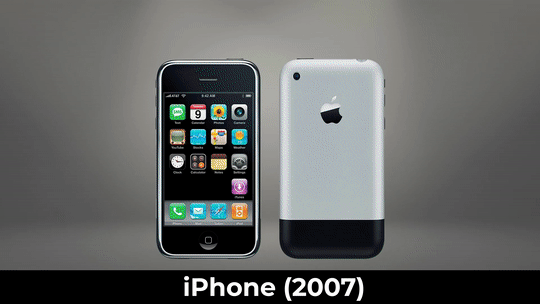
Below we go into more detail about how the history of the iPhone played out. Here is the chronological order of iPhone series release dates:
- iPhone: June 29, 2007
- iPhone 3G: July 11, 2008
- iPhone 3GS: June 19, 2009
- iPhone 4: June 24, 2010
- iPhone 4S: October 14, 2011
- iPhone 5: September 21, 2012
- iPhone 5S & 5C: September 20, 2013
- iPhone 6 & 6 Plus: September 19, 2014
- iPhone 6S & 6S Plus: September 19, 2015
- iPhone SE: March 31, 2016
- iPhone 7 & 7 Plus: September 16, 2016
- iPhone 8 & 8 Plus: September 22, 2017
- iPhone X: November 3, 2017
- iPhone XS, XS Max: September 21, 2018
- iPhone XR: October 26, 2018
- iPhone 11, Pro, Pro Max: September 20, 2019
- iPhone 12, Mini, Pro, Pro Max: October 23, 2020
- iPhone 13, Mini, Pro, Pro Max: September 14, 2021
- iPhone 14, Plus, Pro, Pro Max: September 16, 2022
- iPhone 15: September, 2023
iPhones Still in Circulation
As you can see, most of the iPhones released in the last 12 years have been discontinued, usually two years after being released. While you can still purchase most older iPhone models through discount resellers, Apple is still only officially offering these models through their website:
Table of Contents
The Birth of the iPhone
The first iPhone was released in 2007, but the history of the iPhone starts well before then in the development of multiple different projects all wrapped up under the codename Project Purple.
2003: A New Way to Use Computers?
The birth of the revolutionary technology that would eventually power the iPhone didn’t start with a grand vision for reshaping the way we communicate. It started with a plan to fix the most cumbersome parts of a computer: the mouse.
READ MORE: History of Apple Computers
In 2003, Apple started internal experimentation to find a way to replace the mouse with a touchpad that offered much more control and flexibility. Their initial design, a tablet-sized, finger-controlled interface known as the Model 035, allowed users to pinch, scroll, and zoom – all things that were currently unavailable on modern computers.
READ MORE: The Genesis of Genius: Unveiling Who Invented Apple and When Was the Icon Created
This project was eventually put aside though when it became clear that Apple had more pressing issues…
2004: The Rise and Fall of the iPod
The iPod was released in 2001 and quickly became not only a consumer favorite (eventually selling nearly 400 million units) but also one of Apple’s major revenue streams.
But even as iPod sales were climbing rapidly, Apple’s executive team knew its days were limited. Customers were carrying around both an iPod and a mobile phone and were convinced that the mobile phones would eventually have the ability to play music, something that would make iPods obsolete.
READ MORE: The First Cell Phone: A Complete Phone History from 1920 to Present
To keep the company profitable and maintain its position as a market leader in tech innovation, Apple executives knew they needed to come up with the next generation of mobile phones before their competitors did.
2005: The Rokr E1
Apple’s first step in this direction was to partner with Motorola for the release of the Rokr E1. It was an iTunes-compatible mobile phone that allowed consumers to store songs and play them through an iPod-like interface. Unfortunately, its significant limitations meant it was never going to redefine the market. It was only able to hold 100 songs, its clunky interface was difficult to navigate, and its slow upload rate was frustrating to use.
These limitations made it clear to Apple that they needed to produce their own solution.
2005: The Birth of an Idea
The initial idea to create their own phone with a touchscreen display came straight from the top of the company.
In an appearance at the All Things D conference in 2010, Steve Jobs, Apple’s co-founder and CEO at the time, recounted the moment the idea of the iPhone was born.
“I’ll tell you a secret. It began with the tablet. I had this idea about having a glass display, a multi-touch display you could type on with your fingers. I asked our people about it. And six months later, they came back with this amazing display. And I gave it to one of our really brilliant UI guys. He got scrolling working and some other things, and I thought, ‘My God, we can build a phone with this!’ So we put the tablet aside, and we went to work on the iPhone.”
From there, Project Purple was born.
2006: Project Purple
The Apple research and development team dropped all other projects and this new mobile phone, known internally as “Project Purple,” became the top priority.
The first hurdle Apple had to overcome in developing the iPhone wasn’t related to the technology or the manufacturing. It was building a team!
To avoid their competitors discovering their category-defining innovation, Steve Jobs was adamant that no one from outside the company could work on Project Purple. He was so concerned about security that even those who were being internally recruited couldn’t be told what they were working on before they joined.
Once a team was chosen, they were split into two separate but closely integrated teams: hardware and software. They spent many long nights and weekends brainstorming, testing, and iterating different versions in their dedicated building on the Apple Cupertino campus, and conditions inside the building quickly got weird:
“Very much like a dorm, people were there all the time. It smelled something like pizza, and in fact on the front door of the Purple Dorm we put a sign up that said ‘Fight Club’ – because the first rule of that project was to not talk about it outside those doors.”
Scott Forstall – Apple’s Senior Vice President of iOS
Their hard work eventually yielded results when a design prototype was finalized in Spring 2006, looking quite similar to Apple’s 2004-era iPod Mini (a metallic body with rounded edges).
Internal concerns about the rounded sides making the iPhone appear too large were eventually taken on board, and only a few months before its release, the design was changed to the now-iconic rectangular body with rounded corners and a full-face glass display with a singular button.
2007: The Last-Minute Change to Gorilla Glass
In January 2007, Steve Jobs proudly strode onto the stage at the MacWorld 2007 convention and unveiled the iPhone to raucous applause from loyal Apple fans. But one thing that can’t be seen clearly in that video is that the iPhone he’s holding is not the one that eventually made it into consumers’ hands.
The iPhone Steve Jobs is holding has scratches on the screen. Not because someone had used a piece of sharpened metal to gouge slivers into the glass, but because the screen on the original iPhone is made of hardened plastic – the same plastic used on iPod screens.
The day after his keynote address, Steve called Jeff Williams, the now-head of design at Apple and COO, and told him that the screen had to be changed to glass. Jeff’s team had already covered this:
“I’ve been looking at that, and in 3 to 4 years, technology may evolve, and we can do that.”
Steve’s reply was simple, direct, and straightforward:
“You don’t understand. When it ships in June, it needs to be glass.”
Two days later, Wendell Weeks, the CEO of Corning, called Williams after speaking with the Apple CEO. He had a solution.
In 1962, Corning launched Project Muscle – an innovation drive to find new solutions to existing problems and invent new products.
One of the most promising inventions to come out of this project was known internally as 0317. Engineers tweaked a recently developed method for reinforcing glass and created a new type of glass so strong they could throw fortified tumblers off the roof of their 9-story headquarters without them breaking.
Their internal testing showed that while normal glass could withstand 7,000 pounds of pressure per square inch, Chemcor, as it became known, could withstand 100,000 pounds of pressure per square inch – opening up a new world of applications that were previously unsuitable for glass.
Initial interest was strong, with windshield and eye safety wear manufacturers seeing its potential, but as further testing revealed issues with how the glass shattered when it did break, Corning was forced to put the project back on their research and development shelves.
But the idea to dust it off and experiment further with it came in 2005 with the release of the Motorola Razr V3. It was the first mobile to feature a glass screen and it prompted Corning to explore whether there were any modern applications for Chemcor.
Testing to reduce the thickness of the glass from its 4mm thickness hadn’t produced much progress by the time Steve Jobs called in 2007, but even though Apple was requesting 1.3mm thick super-strong glass, Corning said they could do it.
Hundreds of hours of testing went into the development of what is now known as Gorilla Glass, and just 11 days before the first iPhone was released, Apple issued a press release breaking the news that the iPhone would now have a glass screen.
iPhone Generations Development
With each new generation of the iPhone, Apple has sought to push their phone to the limits of what is technologically capable.
Here is the complete history of the iPhone’s development, sales, access, availability, and controversies.
Generation 1: The First iPhone
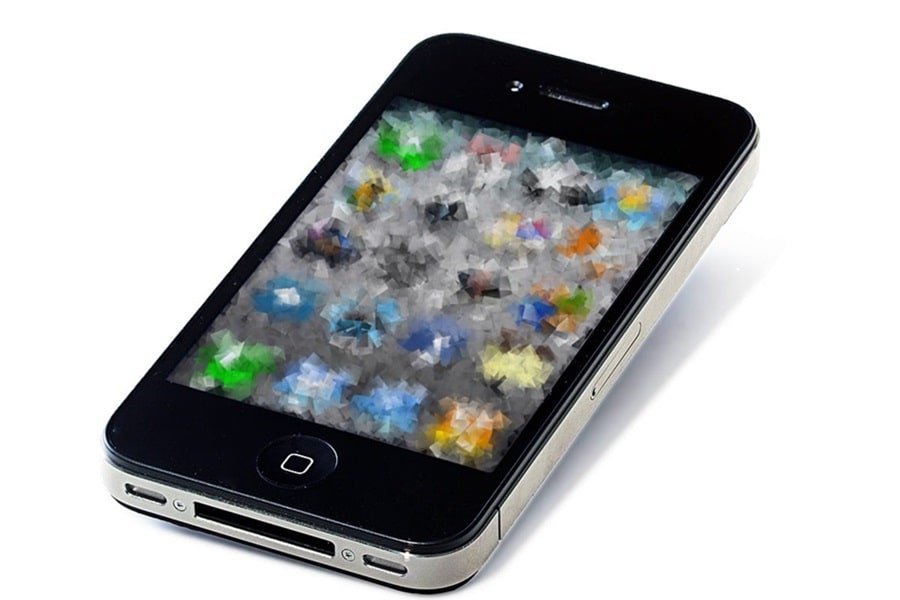
In the months and even years leading up to the release of the first iPhone, rumors had been swirling around the web about an iPod that could also work as a phone.
READ MORE: The Complete History of Phones from the Last 500 Years
When Did the First iPhone Come Out?
When Steve Jobs finally took the stage at the MacWorld convention on January 9th, 2007 to announce “We’re going to reinvent the phone,” iPhone history began, and the era of smartphones was officially upon us.
Later that year, on June 29, 2007, the first iPhone was released in stores in the United States, marking the official beginning of a new era.
To say that Jobs was right that this new product would disrupt the world of phones is an understatement. By September of the same year, Apple had sold its millionth iPhone. Since then, sales have grown steadily, and by 2017, they had sold more than 2 billion iPhones. But what was so special and unique about this first iPhone?
RFEAD MORE: Who Invented Smartphone? Unraveling the History of Mobile Technology
iPhone 2G Features and Functionality
According to Apple, the first version of the iPhone was a combination of three products. It was:
- A revolutionary mobile phone
- A widescreen iPod with touch controls
- A breakthrough Internet communications device with desktop-class email, web browsing, searching, and maps.
It’s natural to want to anoint the innovative touch screen as the most novel feature since up until this point nothing like it existed. But the first iPhone was also a brand new phone in that it allowed people to make calls by simply pointing at and touching a name in their contacts list.
This type of functionality had never been seen before, and it helped make the iPhone truly unique. Furthermore, the introduction of Visual Voicemail made it possible for users to read their voicemails as texts instead of having to listen to them.
The first iPhone also featured a full QWERTY keyboard on a soft touchscreen. Before the iPhone, phones with full keyboards, such as the Blackberry, made use of a hard keyboard, which reduced the size of the screen. Wanting to make the iPhone a full-screen device, Apple invented a touchscreen that was more accurate and more responsive than any other phone in history.
Because of this, the first iPhone was also described as a “full-screen iPod.” This idea of having a full-screen device with a beautiful, easy-to-use interface changed the course of mobile phone history. Today, nearly all smartphones today are built using this design concept.
The other defining feature of the first iPhone was its functionality as a mobile browser and email client. Up until this point in smartphone history, surfing the web on your phone required using a mobile-specific browser that was clunky and featureless. However, with the iPhone, users could now surf the web on Apple’s Safari browser in much the same way that they could on their desktop.
First iPhone Specs
Another thing that amazed people about the first iPhone was its size. Despite its state-of-the-art capabilities, it was just .046 inches (11.6 mm) thick, and it weighed only 4.8 ounces (135 grams). And with a diagonal screen size of just 3.5 inches (8.89 cm), it could easily fit into your pocket or purse. In this sense, it was one of the world’s first true handheld computers. In terms of the screen, the first iPhone boasted a resolution of 320 x 400 pixels and around 160 pixels per inch (ppi), which is the standard measure of pixel density.
READ MORE: The First Computer: Technology that Changed the World
In terms of other specifications, the first iPhone included:
- A 2-megapixel camera (the front-facing camera was not included in the first model)
- A Samsung 32-bit, 412 MHz processor with 128 MB RAM (note: at this point in iPhone history, Apple was not making its own processors)
- Bluetooth 2.0 capability
- The first version of iOS, which was upgradable to iOS 3.3
- WiFi capability
- Document viewer
- Photo/video viewer
- Predictive text input
- 3.5 mm headphone jack
- Google Maps integration
- GPS
- HTML support
- 8 hours talk time on 2G
- 6 hours of battery life on WiFi
- 7 hours of battery life for videos
- 24 hours of battery life for watching videos
- 4GB internal memory ($499) or 8GB ($599)
READ MORE: The First Camera Ever Made: A History of Cameras
First iPhone Countries and Carriers
By Christmas of 2007, Apple dropped these prices, much to the chagrin of consumers, and this helped to boost sales. But one of the things that really held back iPhone sales in the beginning, even though the numbers are still quite staggering, was that the phone was only available in limited countries and on limited networks.
In the U.S., for example, the iPhone was only offered through the wireless carrier Cingular. This would change in the coming years, but an exclusivity contract between the two companies meant that one needed to be a Cingular customer to enjoy the state-of-the-art technology included in the iPhone.
In addition to the United States, the iPhone was also sold in the United Kingdom and Germany using similar exclusive contracts like the one between Apple in Cingular.
During its first year, the iPhone also became available in Belgium and the Netherlands, as well as France. However, Apple soon ran into legal trouble as many European phone carriers sued Apple for its exclusivity contract, a move that caused a temporary halt to iPhone sales in Europe. However, despite this limited release, iPhones got into the hands of people all over the world, and expanding the market became a defining characteristic of the next chapter of iPhone history.
First iPhone Controversy: Early Adopter Tax
While the first iPhone was universally hailed as redefining personal communication, it wasn’t without controversy.
Its initial recommended retail price of $599 was well beyond the cost of a typical mobile phone. While this didn’t deter tens of thousands of Apple fans queuing for hours to get their hands on one, some vocal members of the public complained about the price.
Apple eventually caved to the public pressure and reduced the price to $399 after less than three months after release. Whilst those who had delayed their purchase were happy with the decision, Apple’s early adopters were outraged at having to pay an additional $200.
Apple ultimately listened to the growing frustrations of their most loyal supporters and gave them a $100 Apple gift voucher. Not exactly $200, but enough to show their supporters they were valued.
Generation 2: iPhone 3G

In the first year of iPhone history, there were extremely high levels of customer satisfaction, as well as figures that showed people really were using the phone in the way it was meant to be used, i.e. people were using it for email, web browsing, and calling/texting, according to Steve Jobs. Furthermore, he discussed how six million iPhones had been sold in the product’s first year, with sales stopping only because the company ran out of products.
However, he also identified where the iPhone needed to go next. Specifically, he pointed to five things:
- The iPhone needed to be faster
- The iPhone needed to be cheaper
- The iPhone needed to be available in more countries
- The iPhone needed to be more compatible with third-party apps
- The iPhone needed to be more suited for business
The way in which Jobs discussed these challenges was smart, as these ended up being the defining characteristics of the next chapter of iPhone history.
iPhone 3G Features and Functionality
iPhone 3G was released on July 11, 2008. Although the iPhone 3G ushered in a new era in the history of the iPhone, it was not a tremendous upgrade from the original version of the device. It addressed many of the issues mentioned above, but many other things stayed the same.
The most important change was that the iPhone 3G, as the name suggests, was equipped with 3G capability, which meant users could browse the web and download content much faster than they could with the original iPhone.
Another major change with the iPhone 3G was the introduction of the App Store, iOS 2, and developer software that made it possible for third parties to create their own apps. Technically, this announcement came earlier in the year, but with the release of the iPhone 3G, there was now a device on which developers could place their apps. In this sense, the iPhone 3G turned the device into more than just a phone. It became a platform, a move that has helped turn Apple and the iPhone into the institutions they are today.
In terms of screen size, the iPhone 3G stayed the same as the original iPhone. However, Apple changed from using an aluminum backing to one made of polycarbonate, a move that made the iPhone 3G slightly lighter. It also allowed Apple to offer the iPhone in different colors, black or white.
iPhone 3G Specs
There weren’t a ton of changes between the first iPhone and the iPhone 3G. For example, the phone screen stayed the same size at 3.5 inches (8.89 cm). But because of the new materials, the iPhone 3G weighed slightly less (4.7 ounces/133g as compared to 4.8 ounces/136g), and the screen resolution was bumped up to 380 x 420 pixels, giving it around 165 ppi. As for the other specs, many stayed the same, such as the processor speed and RAM, and most improvements, with the exception of 3G capability, were slight. Here’s a summary of the changes:
- 3G capability
- Bluetooth 2.0+EDR
- iOS 2.0, but can support up to iOS 4.2 (upgraded from the original iOS)
- A-GPS, which allowed for more accurate location services.
- 5 hours talk time or web browsing on 3G
- 10 hours talk time on 2G
- 6 hours of battery life on WiFi
- 7 hours of battery life for videos
- 24 hours of battery life for just music
- 8 GB ($199) or 16 GB ($299) of storage space (up from 4 or 8)
READ MORE: Electrifying History: Uncovering Who Invented the Battery
One of the biggest changes resulting from the release of the iPhone 3G was not only the increased network capacity but also the price. This new version of the iPhone retailed for less than half of the first model.
iPhone 3G Countries and Networks
As Steve Jobs mentioned when introducing the iPhone 3G, Apple made it a priority to expand its market presence to many more countries. So, when the iPhone 3G hit the market on July 11th, 2008, it was sold in stores in the following countries:
- Australia
- Austria
- Belgium
- Canada
- Denmark
- Finland
- Germany
- Hong Kong
- Ireland
- Italy
- Japan
- Mexico
- The Netherlands
- New Zealand
- Portugal
- Spain
- Sweden
- Switzerland
- United Kingdom
- United States
READ MORE: History of Japan: The Feudal Era to the Founding of Modern Periods and US History Timeline: The Dates of America’s Journey
On July 17, 2008, the iPhone was released in France, and by August, it was released in twenty-two more countries, which were:
- Argentina
- Chile
- Colombia
- Czech Republic
- Ecuador
- El Salvador
- Estonia
- Greece
- Guatemala
- Honduras
- Hungary
- India
- Liechtenstein
- Macau
- Paraguay
- Peru
- The Philippines
- Poland
- Romania
- Singapore
- Slovakia
- Uruguay
However, despite expanding to new countries, Apple continued to make use of exclusivity contracts with certain carriers. For example, in the U.S., the iPhone was still only available through one network, AT&T (formerly Cingular). However, elsewhere in the world, these exclusivity contracts were not as ironclad. The iPhone was sold on multiple networks in counties throughout Europe, and this was a sign of what was to come in the next phases of iPhone history.
Generation 3: iPhone 3GS
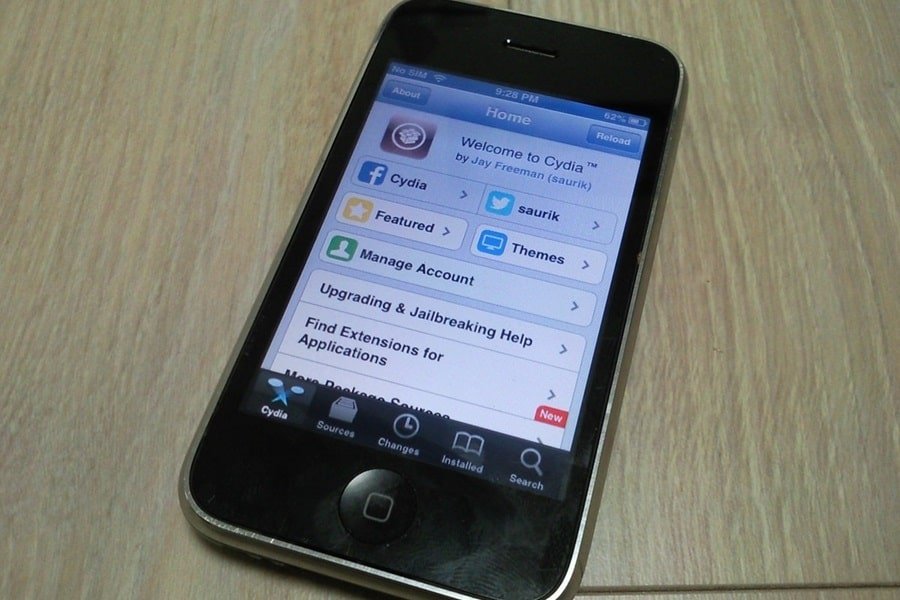
The release of the iPhone 3GS on June 19, 2009, marked a new beginning in iPhone history largely because it was the first iPhone to receive an interim update. The “S” after “3G” became Apple’s way of indicating that the phone was new but that it also maintained many of the same features as the previous version.
Part of the reason for this was that the iPhones had become so popular that people began expecting a new version every year, but the technology was not advancing fast enough for there to be a dramatically new version every year.
In fact, part of the reason why the iPhone 3G came so quickly after the first iPhone was that Apple, in 2007, felt pressure to get the first iPhone onto the market. Some even argue they rushed its release and that the iPhone 3G was the real aim of all the initial research and development that went into the phone.
Nevertheless, by 2009, the iPhone had become a staple in the wireless phone market, and there was an immense incentive to come out with a new version every year to keep up with sales and rising stock prices.
iPhone 3GS Features and Functionality
In terms of features and functionality, the iPhone 3GS did not change all that much from the iPhone 3G. It included all of the same features as the first two iPhones plus:
- VoiceOver for Accessibility
- Voice control (not quite Siri, but we’re on the way)
- Nike + iPod for training
- An inline remote on the headphone cable
These changes were nice, but what really made the iPhone 3GS different was how it was built on the inside.
iPhone 3GS Specs
The main differences that came with the release of the iPhone 3GS were some of its internal specifications. It weighed slightly more than the iPhone 3G, but only by .1 ounces/2.8g (the total weight returned to the original 4.8 oz./136g), but the screen size and resolution stayed the same. This means that the biggest upgrades were made to the camera, the processor, and the battery. More specifically, the iPhone 3G included:
- A 600 MHz processor with 256 MB RAM
- A 3.0-megapixel camera that allowed for video recording
- Bluetooth 2.1+EDR
- A digital compass
- 5 hours talk time or web browsing on 3G
- 12 hours talk time on 2G (up from 10)
- 9 hours of battery life on WiFi (up from 6)
- 10 hours of battery life for videos (up from 7)
- 30 hours of battery life for just music (up from 24)
- 16 GB ($199) 32 GB ($299) of internal memory (up from 8 or 16)
iPhone 3GS Carriers and Countries
At this point in iPhone history, the iPhone was still only available on AT&T in the United States. Abroad, it was carried by several different companies, such as Vodafone, TMobile, O2, Airtel, Movistar, and many more.
With the release of the iPhone 3GS, Apple also expanded the number of countries in which the phone was available, in addition to the countries that were introduced to the iPhone with the release of the 3G, people in the following countries were able to purchase this revolutionary device starting in 2009:
- Botswana
- Brazil
- Bulgaria
- Cameroon
- Central African Republic
- Croatia
- Dominican Republic
- Egypt
- Guinea
- Indonesia
- Ivory Coast
- Jamaica
- Jordan
- Kenya
- Madagascar
- Mali
- Mauritius
- Nicaragua
- Niger
- Latvia
- Luxembourg
- Macedonia
- Malaysia
- Malta
- Mexico
- Moldova
- Montenegro
- Poland
- Russia
- Saudi Arabia
- South Africa
- Senegal
- Taiwan
- Thailand
- United Arab Emirates
- Venezuela
Between the iPhone 3G and the iPhone 3Gs, Steve Jobs and Co. managed to achieve their goal of making the iPhone a truly global device. There are a few notable countries missing from this list, the most prominent being China. But considering the political climate in China and the relative difficulty U.S. companies have selling their products there, this shouldn’t come as much of a surprise. However, the size and the buying power of the Chinese market have always been too much for a company such as Apple to resist. However, it would be some time before the history of the iPhone would begin in the world’s most populous country. Nevertheless, by the end of 2009, there were iPhones in almost every corner of the globe.
Generation 4: iPhone 4
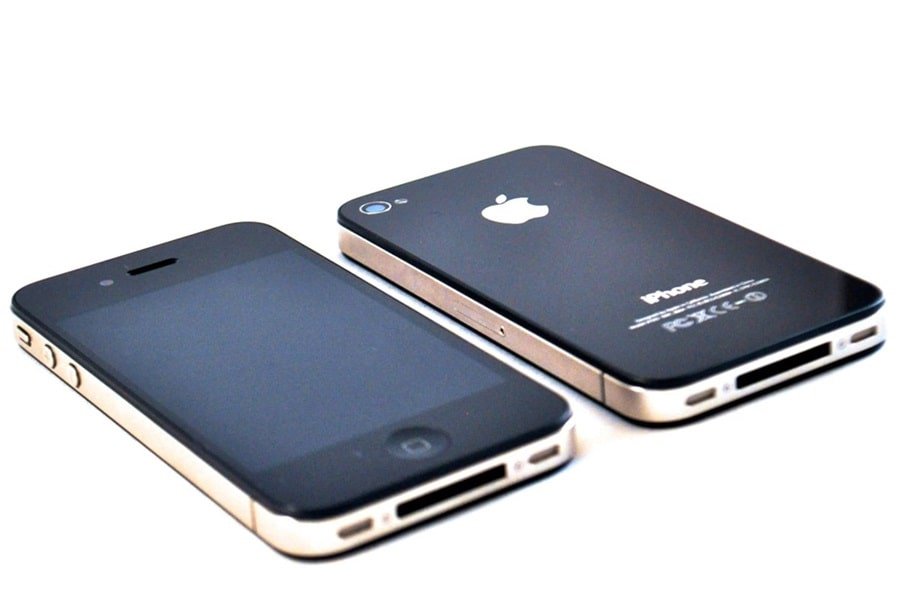
Some 30 million iPhones were sold in the first three years of the phone’s history, making it one of the most popular and highly-desired products in the entire world. However, Apple, with its unquenchable thirst for innovation, wanted to move forward with the latest version of their signature device. So, the iPhone 4, which launched on June 24, 2010, was the first time in iPhone history that Apple did a complete makeover of the device.
Of course, some things stayed the same, but so much of the phone was different that it’s clear to see how the release of this device launched a new era in the history of the iPhone. Many call the iPhone 4 the first “modern phone,” largely because all subsequent models have been based on it in one way or another.
During the launch event, Jobs claimed there were more than 100 new features in the iPhone 4 as compared to the 3GS.
iPhone 4 Features and Functionality
One of the most exciting things to come from the iPhone 4 was the release of FaceTime. Making use of the iPhone’s new front-facing camera, users could easily and clearly video chat with other iPhone users, providing people with a brand new way to communicate with one another.
The ability to use FaceTime is something that helped make the iPhone an even more important device in the lives of so many people around the world. However, what really made the iPhone 4 special were the upgrades it received on the inside as well as its brand-new design.
iPhone 4 Specs
The most obvious difference between the iPhone 4 and all previous models is how it looked. The first versions of the phone were made from glass and plastic, but for the first time ever, a phone was made from stainless steel, which Apple claimed made it stronger and lighter than any other phone in history.
One thing that was interesting about this phone was that Apple built the antennae directly into the phone’s stainless steel frame. This was initially lauded as a feat in engineering, but after some time, it was discovered that this design element actually impeded the phone’s ability to make calls.
For example, putting your hand near the bottom of the phone would cause signal strength to suffer, and it even caused some calls to drop. Steve Jobs famously denied this was an issue when it was brought to his attention by the press and users, a scandal that became known as Atennaegate, but he eventually admitted the design flaw. In the meantime, Apple gave the iPhone 4 users a bumper to put around the phone that prevented signal issues.
However, despite this problem, the iPhone 4 was still one of the most innovative versions of the device to ever be released. It was a full 25 percent thinner than the iPhone 3GS, but it still weighed 4.8 ounces/136g. The screen size remained the same, but it received a major upgrade. The new version’s resolution was improved to 960 x 640 pixels. However, the biggest upgrade came in pixel density. The Phone 4 screen produced 326ppi, which was twice that of all previous models, giving the iPhone 4 the clearest screen in iPhone history.
Apple dubbed this “Retina display” because it claimed this level of clarity was higher than that which the human eye could perceive, making text on the screen appear more like that of a printed book. This claim came under scrutiny, but nevertheless, these specs made the phone’s screen one of the clearest and most precise the world has seen. It would be seven years before Apple came out with a screen better than this one.
Other device specs include:
- A 5-megapixel rear camera with LED flash capable of recording videos in 720p
- A VGA-quality front-facing camera for FaceTime
- A 32-bit, Apple A4 processor, with speeds up to 1GHz and 512MB of RAM (the first time Apple included its own processor in the device)
- A Micro-sim tray (GSM versions only)
- 2 microphones, one for noise canceling to help make calls clearer
- A 3-axis gyroscope
- iOS 4.0, upgradable to iOS 7
- 7 hours talk time on 3G (up from 6)
- 6 hours of web browsing time on 3G (up from 5)
- 14 hours talk time on 2G (up from 12)
- 10 hours of battery life on WiFi (up from 9)
- 10 hours of battery life for videos (no change)
- 40 hours of battery life for just music (up from 30)
- 16 GB ($199) 32 GB ($299) of internal memory (no change) with a two-year contract with AT&T
READ MORE: Who Invented The Microphone? The Story of Alexander Graham Bell
iPhone 4 Countries and Carriers
In terms of new countries and carriers, not much changed with the release of the iPhone 4. However, in February 2011, before the release of the next version of the iPhone, Apple released a new version of the device that could function on CDMA networks. This marked an important moment in iPhone history as it meant that the phone could now work on Verizon and Sprint in the U.S., which effectively ended the exclusivity between Apple and AT&T that had defined the first three years of iPhone history. On February 10, 2011, Verizon sold its first iPhone, and in October of that year, the phone became available to Sprint customers as well.
iPhone 4 Controversy: Antenna-Gate
As sales of the iPhone 4 continued to climb, consumers started to notice an annoying glitch – when they held their phone in a particular way, they lost reception. The existence of this issue was repeatedly denied by Apple execs.
As public awareness and frustration with this issue continued to grow, Apple finally acknowledged it as a real problem.
Their solution was not well received – “Just avoid holding it in that way.”

The considerable backlash to this obviously inadequate solution prompted Apple to eventually offer free cases to all iPhone 4 users.
Generation 5: iPhone 4S
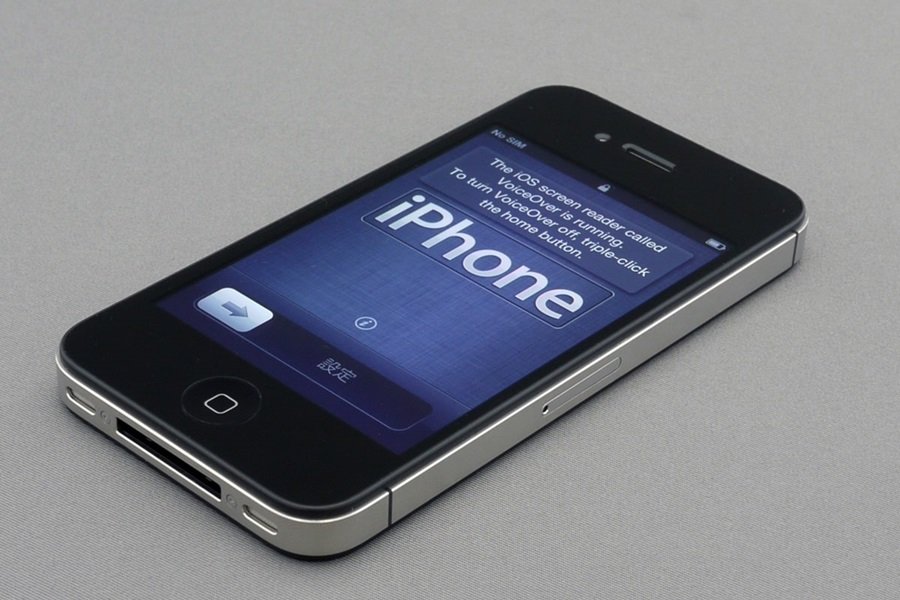
After several years of releasing the iPhone in the summer, Apple changed things up in 2011 by releasing the newest version of the device in October. Much like the iPhone 3GS, the iPhone 4S was an interim update to the phone. It gave it some new features and increased functionality, but most of the device stayed the same.
However, the iPhone, for the first time ever, had become available on all three major U.S. networks, opening the door for record first-weekend sales. More than 1 million were sold on the first day, and Apple sold just over 4 million on the first weekend.
But the release of the iPhone 4S will go down in iPhone history as a momentous one for other reasons. Steve Jobs, one of Apple’s founders and one of the world’s most well-known entrepreneurs, passed away from pancreatic cancer just nine days before the phone was released to the world.
iPhone 4S Features and Functionality
The previous few upgrades Apple made to the iPhone were centered on improving its speed, screen, and cameras. The iPhone 4S was upgraded in all of these areas, but it also included some exciting new features that had never before been seen in iPhone history.
Perhaps the most exciting change was the introduction of Siri, Apple’s voice-controlled assistant that is still in use today and that in many ways introduced the consumer world to the functionality of Artificial Intelligence.
In addition to Siri, Apple also introduced iCloud, which allowed people to store photos, videos, music, contacts, and much more in the cloud, which freed up space on the device, something they most likely did in response to the complaint that there was never enough storage space on the iPhone. Apple also introduced iMessage to make texting between iPhone users easier, a notifications center, reminders, and Twitter integration helping the iPhone stay at the top of the smartphone world.
READ MORE: Who Invented Twitter? The Origins of a Revolutionary Social Media Platform
iPhone 4S Specs
When the iPhone 3GS was released, we were told the “S” stood for “speed,” meaning the focus of the upgrade was on making the phone faster. This was the case with the iPhone 4S, but the device also received other upgrades. Screen resolution and size stayed the same, but the iPhone 4S also included:
- An 8-megapixel camera capable of shooting videos in 1080p (up from 5 mp and 720p)
- An Apple A5, 32-bit, dual-core processor with speeds up to 1 GHz and 512 MB RAM
- Bluetooth 4.0
- iOS 5 (upgradeable to iOS 9)
- 8 hours talk time on 3G (up from 7)
- 6 hours of web browsing time on 3G (no change)
- 14 hours talk time on 2G (no change)
- 9 hours of battery life on WiFi (down from 10)
- 10 hours of battery life for videos (no change)
- 40 hours of battery life for just music (up from 30)
- 16GB ($199) 32GB ($299), or 64GB ($399) of internal memory (64GB model was added with the 4S)
Despite a host of new features and upgraded specs, Apple received a good deal of criticism from the general public for not doing enough with the iPhone 4S. By 2011, 4G LTE networks were growing in popularity, and many thought Apple would take the leap and release a phone ready to handle faster network speeds. However, analysts dubbed this release as a move towards the future, as the 4S set up the release of the iPhone 5, which really would change the course of iPhone history forever.
iPhone 4S Countries and Carriers
One of the biggest things to happen with the release of the iPhone 4S was making the device available on all three major U.S. networks, AT&T, Sprint, and Verizon.
In terms of countries, though, the iPhone 4S is monumental because it was the first time a full version of the iPhone was released in China. Counterfeit and stolen devices had been on the market for years, and in 2011 Apple released a version of the iPhone 3GS that didn’t have WiFi, but in January 2012, the iPhone 4S went to China, giving Apple unprecedented access to one of the world’s largest markets.
Generation 6: iPhone 5
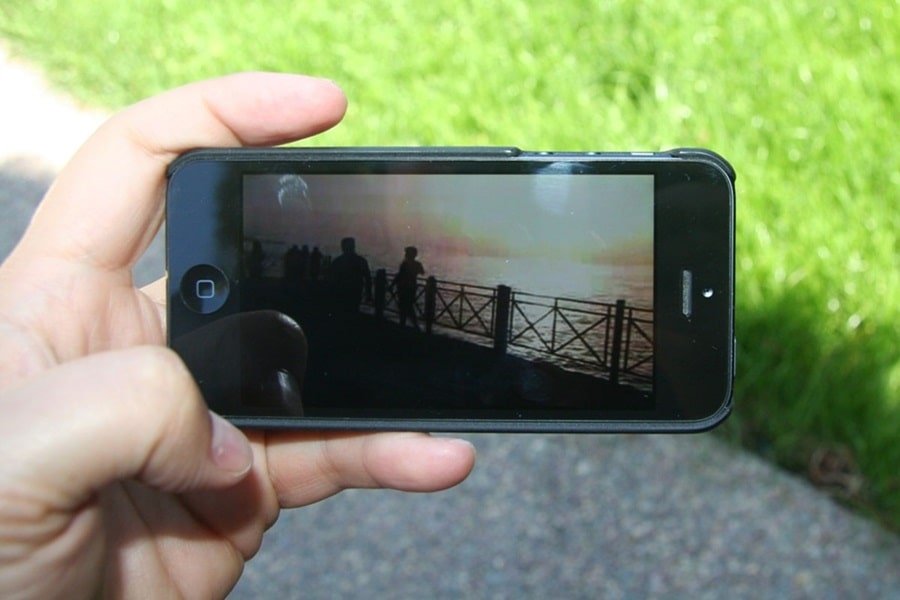
While for some the release of the iPhone 5 came a year late, there’s no doubt that it was an exciting moment in iPhone history, mainly because it was the first iPhone to make use of the ultra-fast LTE networks being offered by AT&T and Verizon at the time. However, this was far from the only upgrade made with the iPhone 5.
iPhone 5 Features and Functionality
While the iPhone 5 represented an exciting change in the hardware and software Apple used to make its devices, this new version did not offer much in terms of new features, but there were some, such as:
- An improved Siri
- Apple Maps with turn-by-turn navigation
- Apple Passbook (the precursor to Apple Wallet)
- Do Not Disturb
- FaceTime over cellular networks (previously, it only worked on WiFi)
- Facebook integration
These upgrades certainly made the device better, but the real improvements came with its specifications.
iPhone 5 Specs
The biggest change that came with the iPhone 5 was related to the display. After years of an iPhone with a 3.5-inch display, Apple finally made a change by expanding the screen to 4 inches. They also made the screen taller, giving it a resolution of 1136 x 640, a perfect 16:9 aspect ratio. Apple kept the 326 ppi Retina display, but by making the device taller, it fit more easily into a user’s hand.
Another major change came with the materials. After switching from glass and plastic to glass and stainless steel with the iPhone 4, Apple decided to change once again and make the iPhone 5 with glass and aluminum, a move that made this the lightest device in iPhone history. It weighed just 3.95 ounces (112 grams), which is 20 percent lower than the iPhone 4 and 4S. The iPhone 5 was also considerably thinner, and part of the reason Apple was able to do this was that it found a way to embed touch sensors into the screen, eliminating the need to put an extra layer on the phone to detect your fingers, something that naturally made the phone thicker.
One more upgrade, one that many people didn’t like at the time, was the switch from a 30-pin connector that had been in use since the first iPod to a digital lightning connector. This meant the new iPhone needed a new charger, but it also allowed for faster charging speeds. Other specifications of the iPhone 5 include:
- An 8-megapixel camera capable of recording in 1080p (camera stayed the same, but video quality was upgraded from 720p)
- A 1.2-megapixel front-facing camera (previous only VGA-quality, which is around 0.3 megapixels)
- An Apple A6, 32-bit, dual-core processor capable of speeds up to 1.3 GHz and 1GB of RAM (up from 1GHz and 512MB RAM)
- LTE capability (first iPhone to have this)
- iOS 6
- 8 hours talk time on 3G (no change)
- 8 hours of web browsing time on 3G (up from 6)
- 8 hours of web browsing time on LTE
- 10 hours of battery life on WiFi (restored to iPhone 4 levels)
- 10 hours of battery life for videos (no change)
- 40 hours of battery life for just music (up from 30)
iPhone 5 Countries and Carriers
By now, the iPhone was being sold on countless networks in countless countries. Just over five million iPhones were sold the first weekend the iPhone 5 was available, the most ever for the first weekend, although this number disappointed stockholders who were expecting sales figures to be much higher. The phone launched in the US, Canada, Australia, and most of Europe on September 21, 2012, and by the end of the year, it was available in more than 100 countries around the world.
Generation 7: iPhone 5S and iPhone 5C

The release of the iPhone 5S and 5C marks an interesting moment in iPhone history, largely because it was the first time Apple released two iPhones at one time. Part of the reason for this was that Apple was now up against more competition than ever. Other phone companies, such as Samsung, had begun releasing phones that could do similar things as the iPhone, and to keep up, Apple needed to offer people more options. The differences between the iPhone 5S and 5C demonstrate this new perspective.
iPhone 5C
The first thing you notice with the iPhone 5C is color. For the first time ever, Apple offered customers the chance to buy an iPhone in a color other than black or white. The 5C had five color options: green, blue, yellow, pink, and white. The iPhone 5C also had a polycarbonate shell over steel, which made it slightly thicker (.35 inches/88mm thicker than the 4S and, .05 inches/12mm thicker than the 5 or 5S), and it also weighed slightly more (4.66 ounces/132g, .07 oz/2g less)
Beyond these slight changes in appearance, however, the iPhone 5C was really not all that much different than the iPhone 5. It featured a slightly better camera, although improvements were made to how the phone processes photos instead of megapixels. It had the same processor, and Apple offered a 16 and 32GB version of the iPhone 5C, choosing not to offer the 64GB version that came with the iPhone 5. The 5C did, however, have slightly improved battery life. Official metrics were:
- 10 hours talk time on 3G (up from 8)
- 10 hours of web browsing time on 3G (up from 8)
- 10 hours of web browsing time on LTE (up from 8)
- 10 hours of battery life on WiFi (no change)
- 10 hours of battery life for videos (no change)
- 40 hours of battery life for just music (no change)
iPhone 5S
Of the two phones released in 2013, the iPhone 5S was the one that really stepped things up, although some of the changes were considerably more modest as compared to past upgrades.
iPhone 5S Features and Functionality
The most exciting new feature to come with the iPhone 5S was the introduction of biometrics. This allowed users to scan their fingerprint into the phone and unlock the device doing nothing more than touching their finger to the home button.
Another interesting feature of the iPhone 5S was the ability to record videos in slo-mo. This move was likely in response to the fact that phones had become much more than phones. They were now cameras and so much more, and Apple responded by improving the functions the phone’s camera could perform.
The iPhone 5S also came with Touch 3D, which allowed users to navigate the touchscreen with more than one finger, an addition that allowed people to be able to zoom in on photos or map much more easily.
iPhone 5S Specs
At first glance, the iPhone 5S looks to be exactly the same as the iPhone 5. Both phones are the same size, they have identical screens (4-inch/10 cm screen, 1136 x 640 pixels, 326 ppi Retina display), and they weigh exactly the same. However, the iPhone 5S had several new features, and these were made possible by some rather significant upgrades to what’s inside the iPhone, mostly to its speed, as the designation “S” would indicate. Here are some of the things that were new with the iPhone 5S
- An 8-megapixel rear camera with an improved aperture and two-tone flash to improve photo quality in low light
- An Apple A7 dual-core, 64-bit, 1.4 GHz processor with 1GB RAM
- An M7 Motion Coprocessor helps the phone process sensory data, such as movement and orientation.
- iOS 7
- 10 hours talk time on 3G (up from 8)
- 10 hours of web browsing time on 3G (up from 8)
- 10 hours of web browsing time on LTE (up from 8)
- 10 hours of battery life on WiFi (no change)
- 10 hours of battery life for videos (no change)
- 40 hours of battery life for just music (no change)
- 16GB ($199), 32GB ($299), 64GB($399)
iPhone 5S and 5C Countries and Carriers
When the iPhone 5 was released, sales figures disappointed, despite selling five million phones in the first weekend. Perhaps this slight disappointment in terms of the number of sales was why Apple decided to come out with two phones simultaneously. And if it was, then Apple made the right move, for they sold just over nine million iPhones on the day these phones were released.
Continuing the trend Apple set with its previous iPhones, the iPhones 5S and 5C were first released in the United States, Australia, Canada, and Europe, on September 20, 2013, and by the end of that year, the device was available in countries where the iPhone 5 was sold. However, since this version, as well as the iPhone 5, were LTE devices, the device was not available until the network had been updated.
Generation 8: iPhone 6 and 6 Plus
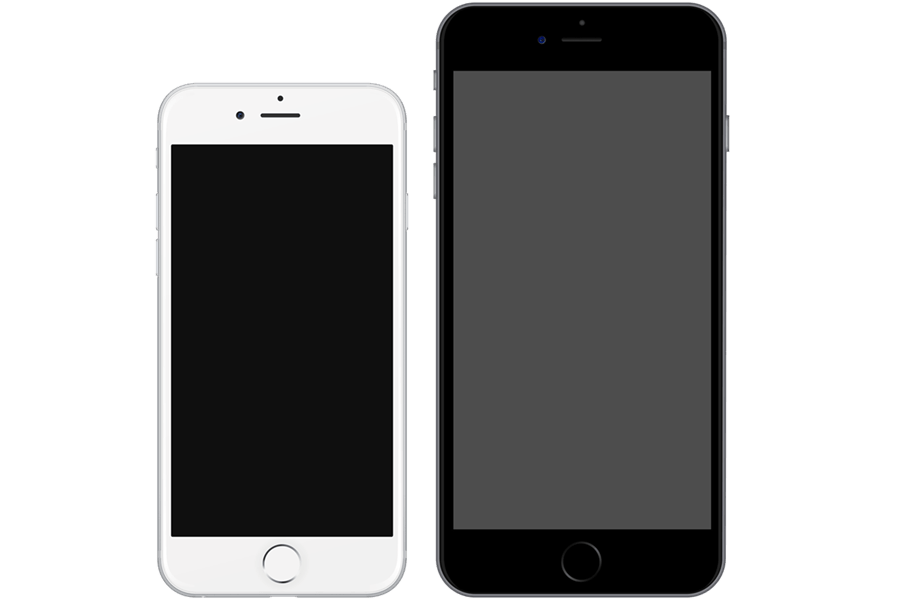
At this point in iPhone history, the yearly release of the new device had become more than tradition. Although some of the initial shock and awe had worn off, people still lined up for the new device, and first-weekend sales continued to be through the roof. However, at this point in the history of the iPhone, we can raise an important question: what else can they do?
However, this type of thinking is typical of those who aren’t working on the inside. We look at these devices and consider them magic, whereas the engineers developing them see them as works in progress. Then, when the new phone comes out, we’re once again wowed at their ability to make a product many already considered great even better.
One thing Apple did with this iPhone that had nothing to do with the device itself was release two versions at the same time. The only other time this had been done in iPhone history was with the release of the iPhone 5C and 5S, but these were interim models. The release of the iPhone 6 was the first time it was done with a completely new model.
iPhone 6 and 6 Plus Upgrades and Improvements
The most noticeable difference with the iPhone 6 was the screen. The iPhone 5 gave us a 4-inch screen that was taller and made it easier for the phone to fit in our hands. However, with the iPhone 6, the screen was now 4.7 inches/11.9cm with a resolution of 1334 x 750 pixels, and it continued to have 326 ppi. The iPhone 6 Plus, on the other hand, had an even bigger screen. It measured 5.5 inches/14cm with a resolution of 1920 x 1080, giving it a pixel density of 401 ppi. Apple dubbed this “Retina display HD.” Both screens had a sharper contrast, which made the colors more vivid.
Because of their difference in size, the iPhone 6 Plus was slightly heavier than the iPhone 6. It weighed 6.07 ounces/172g. The 6 weighed 4.55 ounces/128g, which was 0.11 ounces, or 3 grams, less than the iPhone 5. However, beyond these superficial differences, the iPhone 6 and iPhone 6 Plus were identical.
Both offered an exciting new feature known as Near Field Communication (NFC). This enabled the iPhone to be used as a payment device, and it gave birth to Apple Pay, a service that allows people to pay for things by simply placing their phone next to a payment terminal. It took some time for this technology to become more mainstream, but part of the reason it did was because of the iPhone 6. Here’s a summary of the improved specs for both the iPhone 6 and iPhone 6 Plus.
- An 8-megapixel camera with increased slo-mo capabilities.
- An Apple A8, 64 bit, 1.4 GHz processor with 1 GB RAM
- An M8 Motion Coprocessor
- iOS 8
- Bluetooth 4.2
Battery life, however, is slightly different depending on the model. The battery in the iPhone 6 received modest upgrades, whereas the battery in the iPhone 6 Plus got quite a bit better. Here are the details of battery life for the iPhone 6:
- 14 hours talk time on 3G (up from 10)
- 10 hours of web browsing time on 3G (no change)
- 10 hours of web browsing time on LTE (no change)
- 11 hours of battery life on WiFi (up from 10)
- 11 hours of battery life for videos (no change)
- 50 hours of battery life for just music (up from 40)
Here is what the iPhone 6 Plus could do as compared to the iPhone 5S:
- 24 hours talk time on 3G (up from 10)
- 12 hours of web browsing time on 3G (no change)
- 12 hours of web browsing time on LTE (no change)
- 12 hours of battery life on WiFi (up from 10)
- 14 hours of battery life for videos (no change)
- 80 hours of battery life for just music (up from 40)
As for internal storage, there were three versions of each: 16GB ($199/$299), 64GB ($299/$399), and 128GB ($399/$499)
iPhone 6 and 6 Plus Sales
To give you an idea of just how much of a tradition the release date of new models had become in iPhone history, consider that Apple sold 10 million phones on the first weekend the phone was available. This beat the record of nine million that had been set with the release of the iPhone 5S and 5C, and it demonstrates just how popular these devices had become.
iPhone 6 Controversy 1: An Unwanted Gift
To coincide with the release of the iPhone 6, Apple struck a deal with U2 to release their new album Songs of Innocence exclusively on iTunes as a gift to all iTunes users. This not only resulted in the largest album release of all time, with over half a BILLION users in the Apple database but also considerable backlash from those who didn’t want it.
The negative press eventually led to Apple releasing a tool that allowed users to remove the album from their purchase history.
iPhone 6 Controversy 2: Bendgate
Within weeks of the launch of the iPhone 6 and the U2 drama, another issue became apparent: the iPhone 6 and 6 Plus would bend if enough pressure was applied.
Apple denied that Bendgate was the result of any design or manufacturing flaw and that only 9 people had experienced any issues under normal use conditions. Although, they did acknowledge that as per their warranty conditions, if the iPhone had been subject to normal use conditions and was faulty, it would be replaced.
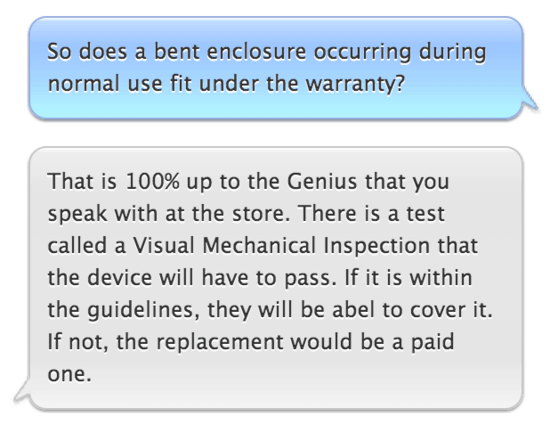
Despite their public denials of any design or manufacturing issues, internal Apple documents, unsealed in 2018 by Lucy Koh in the ‘Touch Disease‘ class-action lawsuit, show that Apple was aware that the iPhone 6 was 3.3 times more likely to bend than the iPhone 5s and the iPhone 6 Plus was 7.2 times more likely to bend.

Apple eventually made significant design changes to help prevent this issue with the addition of Series 7000 space-grade aluminum, even though they have never publically acknowledged an issue existed.
Generation 9: iPhone 6S and iPhone 6S Plus
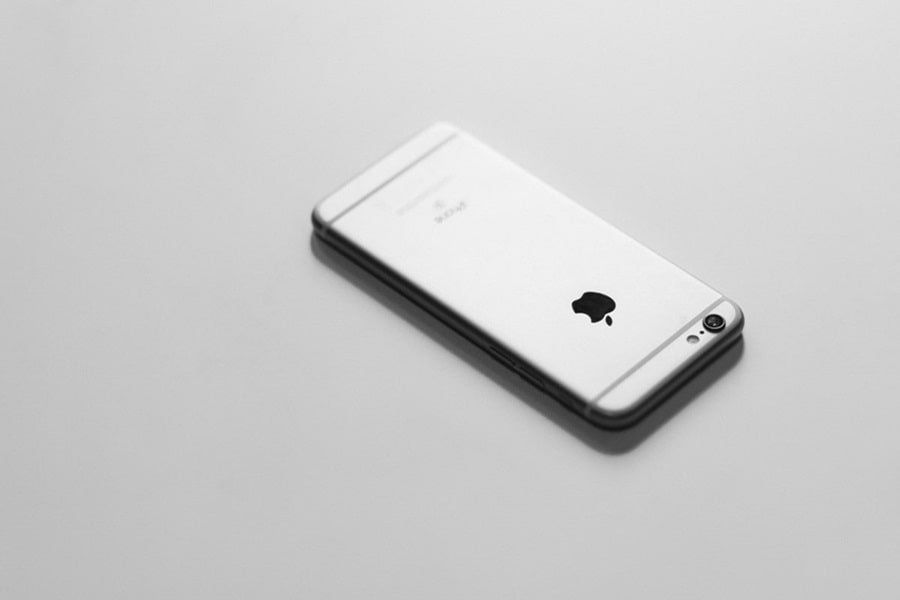
Like the other interim updates in iPhone history, the release of the iPhone 6S and iPhone 6S Plus was designed to offer slight upgrades on the previous version. However, these slight upgrades brought significant improvements to the phone’s performance and user experience. user experience. Like the iPhone 6 and 6 Plus, the 6S and 6S Plus are almost identical. The only difference is that the iPhone 6S is larger than the iPhone 6.
iPhone 6S and 6S Plus Upgrades and Improvements
As is typical in iPhone history, the improvements to this version of the phone came mostly on the inside. However, one noticeable difference in terms of features and functionality is that this version of the phone was the first to have 3D touch. This allowed the phone to distinguish between a tap, a light press, and a hard press, which allowed for more features and made the phone easier to use.
On the inside, the upgrades made to this phone were of similar nature as previous updates, meaning it was faster and had better battery life. But the iPhone 6S also had an improved camera, something that hadn’t happened for some time in iPhone history. Just like the first version of the iPhone 6, the Plus was larger, but the iPhone 6S Plus was the same size as the original iPhone 6 Plus.
In terms of specs, here’s what was new with the iPhone 6S:
- A 12-megapixel camera (up from 8) capable of recording videos in 4K
- A 5-megapixel front-facing camera
- An Apple A9, dual-core, 64-bit processor with 2 GB RAM (up from 1 GB)
- An M9 Motion Coprocessor
- iOS 9
- Bluetooth 4.2
Internal storage options and prices remained the same. There were three different options, 16GB ($199/$299), 64GB ($299/$399), and 128GB ($399/$499). In terms of battery life, both versions of the phone received an upgrade. The Plus version naturally has more battery life since the battery is physically larger. Here’s a summary of how long the battery lasts for different tasks on each device:
- 14/24 hours talk time on 3G
- 10/12 hours of web browsing time on 3G
- 10/12 hours of web browsing time on LTE
- 11/12 hours of battery life on WiFi
- 11/14 hours of battery life for videos
- 50/80 hours of battery life for just music
iPhone 6 Sales
Initial sales of the iPhone 6S allowed Apple to once again break its own record in terms of first-weekend sales. Reports indicate it sold just over 13 million phones on the first weekend. However, many argue that the iPhone 6S was a turning point in Apple’s history. Explosive growth became harder to achieve after this phone as competition ramped up and as it became more and more difficult for Apple to come up with new “must-have” features. Nonetheless, the iPhone remained Apple’s core product, and its subsequent versions would add colorful chapters to the history of the iPhone.
Generation 10: iPhone SE
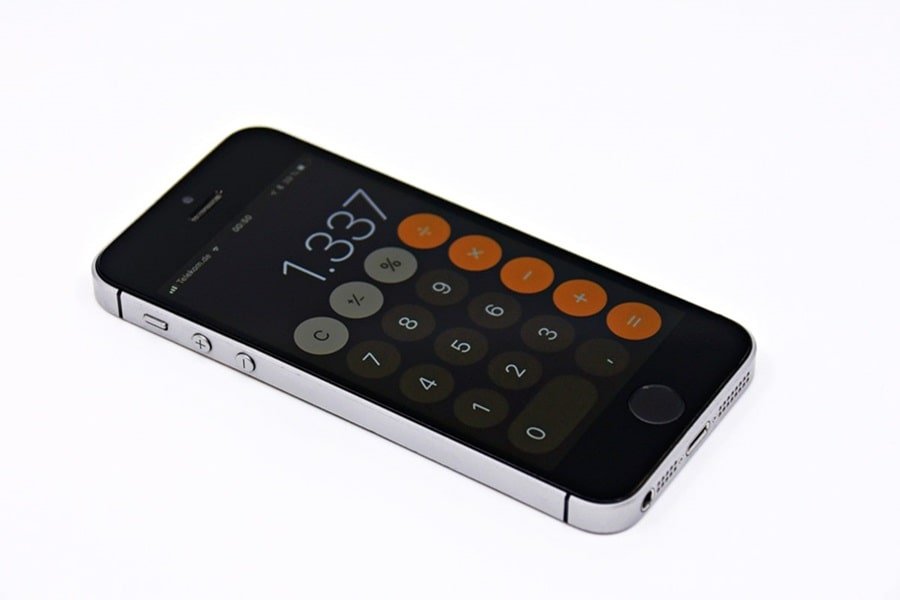
Just six months after the release of the iPhone 6S, Apple decided to release yet another iPhone. However, this phone was not designed so much as a groundbreaking device but rather as a response to the market.
After selling 30 million 4-inch iPhones in 2015, Apple decided to introduce an upgraded version of the iPhone 5 largely because it has learned that some people just prefer smaller, more compact phones. The phone was upgraded as compared to the original iPhone 5, and it was designated SE, which means Special Edition. Here are the specs of the iPhone SE:
- 4-inch screen
- 4.0 ounces (second lightest device in iPhone history)
- A9, dual-core, 64-bit, 1.83 GHz processor with 2GB RAM
- 12-megapixel rear camera
- 1.2-megapixel front camera
- iOS 9.3
- NFC
- Bluetooth 4.2
- 24 hours talk time on 3G
- 12 hours of web browsing time on 3G
- 13 hours of web browsing time on LTE
- 13 hours of battery life on WiFi
- 13 hours of battery life for videos
- 50 hours of battery life for just music
Essentially, the iPhone SE took many of the hardware upgrades that came from the iPhone 6 and 6S and put them into a phone that looked more like the iPhone 5, giving those who prefer smaller phones the best of both worlds.
Generation 11: iPhone 7
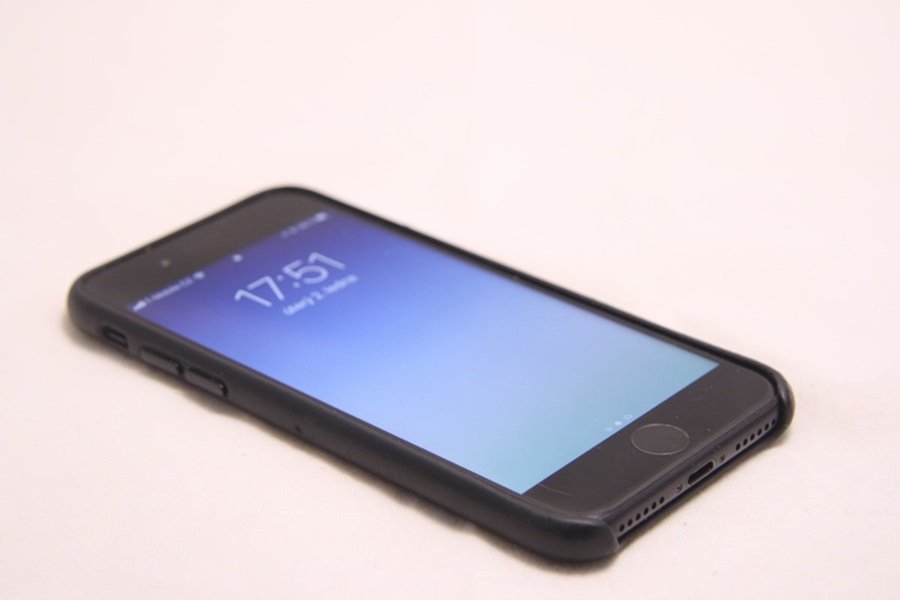
Just about a year after the release of the iPhone 6 and 6 Plus, Apple once again unleashed a new set of its signature device. At first glance, the iPhone 7 and 7 Plus don’t appear to be all that different from the iPhone 6 and 6 Plus, but there was one major change to the appearance. Apple got rid of the headphone jack. This was the first time in iPhone history that users would have to connect their headphones via BlueTooth, and the company was heavily criticized for this move.
READ MORE: Who Invented Bluetooth? Story of the Bit Bouncer
However, most people liked what Apple did with the rest of the phone. For example, this was the first iPhone to be water and dust-resistant, and the introduction of iOS 10 made apps such as Maps, Photos, and Music run more smoothly, and it also introduced some new features to Messages, such as special effects for messages.
As for other upgrades, the iPhone 7 received the usual gambit of improvements, such as an improved processor and better battery life. Screen sizes stayed basically the same, as did screen resolution and pixel density. In addition to screen size, the 7 Plus featured two rear cameras to help deliver even better quality images. However, beyond this, the two phones were pretty much the same. Here is a summary of what was new with the iPhone 7 and 7 Plus:
- 7-megapixel front-facing camera
- Apple A10 quad-core, 64-bit, 2.3 GHz processor with 2GB RAM (3GB for 7 Plus)
- M10 Motion Coprocessor
- Stereo speakers
- iOS 10
- 14 (7)/21(7+) hours talk time on 3G
- 12/13 hours of web browsing time on 3G
- 12/13 hours of web browsing time on LTE
- 14/15 hours of battery life on WiFi
- 13/14 hours of battery life for videos
- 40/60 hours of battery life for just music
- 32GB, 128GB, 256GB ($449-659)
One thing to note here is the higher prices, which resulted from the decision by many wireless carriers to stop offering discounts for two-year contracts. Instead, customers had to pay for phones in full, either upfront or via monthly payments, which increased the cost to the customer, although these numbers were close to what the phones cost all throughout iPhone history.
Generation 12: iPhone 8 and 8 Plus
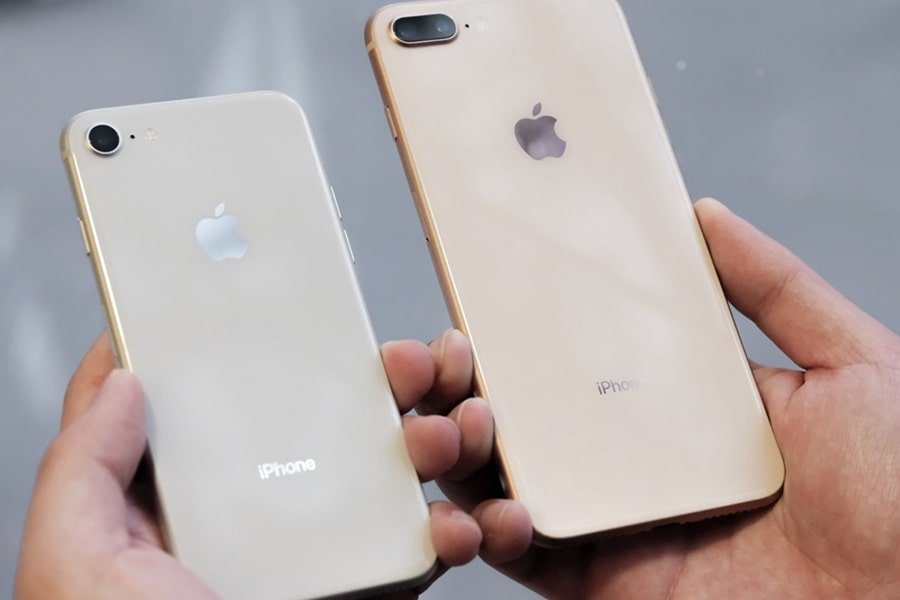
The two new models were released on September 22, 2017. For the first time in the history of the iPhone, Apple chose not to release an “S” version of their previous iPhone. Instead, they skipped right to the iPhone 8 and iPhone 8 Plus. However, if you’ve been paying attention to the last few chapters of iPhone history, you’ve likely noticed that the previous versions offered little in terms of radically new features. Instead, Apple chose to simply install faster processors and better cameras, as these were the things the public demanded. With the iPhone 8, things were not much different.
However, Apple did introduce one new thing with the iPhone 8 and 8 Plus: inductive charging, which is often referred to more commonly as wireless charging. This feature allows the iPhone to be charged without being plugged in, although you need a special device to make this work.
The only other major novelty to come with the iPhone 8 was an improved processor. This new version of the phone has an Apple A11 quad-core, 64-bit, 2.4 Ghz processor with 2GB RAM (3GB for plus.) The motion coprocessor was improved to an M11, and the camera lens was also upgraded slightly. Furthermore, the iPhone 8 and 8 Plus came with the newest version of Apple’s operating system, iOS 12, and there were two choices in terms of internal memory: 64GB and 256 GB. Prices ranged from $599-849.
Battery life stayed the same for the most part, but it actually decreased for some tasks Here’s how long the iPhone 8 and 8 Plus could last by activity:
- 14 (7)/21(7+) hours talk time on 3G
- 12/13 hours of web browsing time on 3G
- 12/13 hours of web browsing time on LTE
- 12/13 hours of battery life on WiFi
- 13/14 hours of battery life for videos
- 40/60 hours of battery life for just music
Generation 13: iPhone X
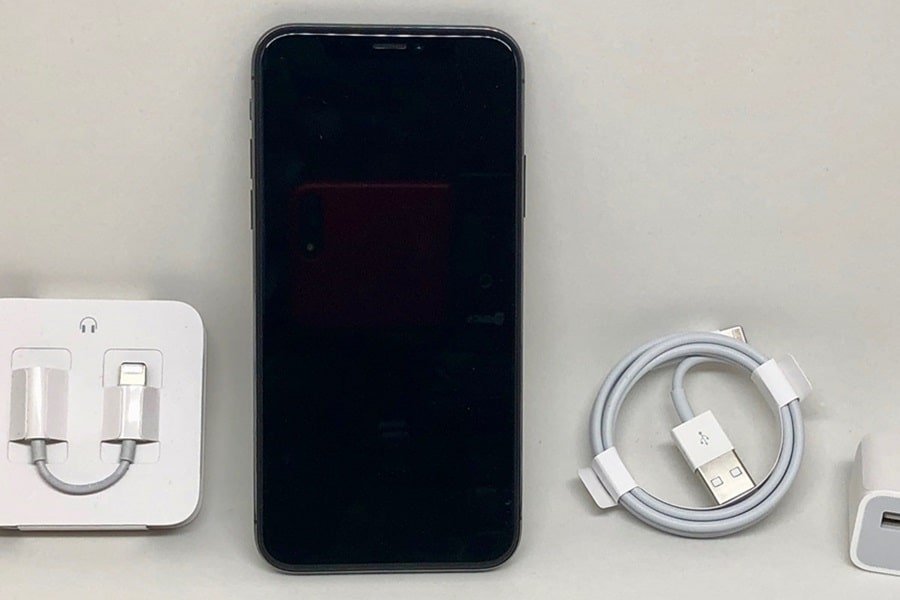
iPhone X was released on November 3, 2017. After some years of releasing iPhones that were more or less the same as the previous year’s version but with slight improvements, Apple once again went for shock value when it released the iPhone X, a moment that was supposed to mark a new beginning in the history of the iPhone. Apple also broke with recent tradition when releasing this phone by only offering one version of the device.
All versions of the iPhone that have been released since 2017 have been modeled off the iPhone X, and we can expect that to continue in the future. But no one really knows for sure.
iPhone X Features and Functionality
The first thing that jumps out about the iPhone X is that it is all screen. Apple did away with much of the material surrounding the screen, and it put in an OLED display that covers the entire surface of the phone. In doing this, though, Apple made a big change: it got rid of its signature “Home button.” This created a major change in the user experience, as you now need to swipe up with your finger to exit apps and switch between screens. Doing away with the Home button, though, means there is no more Touch ID. But to compensate, the iPhone X has facial recognition, meaning all you need to do is look at your phone to unlock it.
Another new feature of the iPhone X are Aniemojis, which are emojis that move on the screen and that can be created using an avatar based on your own face. While this is hardly a technological breakthrough, it certainly made the iPhone more fun.
iPhone X Specs
Although the iPhone X has a whole host of new internal features, it’s hard to not start with the screen. First, at 5.6 inches/14.2cm, it’s larger than the screen found on any other iPhone. Second, the iPhone X is the first in iPhone history to have an all-OLED screen. This allows it to have a screen resolution of 2436 x 1125 pixels, which provides 458 ppi. Apple has dubbed this screen Super Retina.
Other improvements included in the iPhone X are:
- Two 12-megapixel rear cameras
- A 7-megapixel TrueDepth front-facing camera that can recognize facial expressions and which powers Face ID
- Augmented reality capabilities
- An A11 Bionic processor features 6 cores, 2.4 GHz, and 3GB RAM
- iOS 11
- Bluetooth 5.0
- 21 hours of talk time
- 12 hours of internet use
- 13 hours of wireless video playback
- 64 GB ($999) or 256 GB ($1149)
These phones are getting more expensive. The first iPhone, which retailed between $499 and $599, was deemed “too expensive” at the time, but by 2017, Apple was charging $1,000 for their devices, a change that indicates a shift in consumer preferences. In short, phones are no longer just phones. They are mini-computers and people are willing to pay top dollar for them.
iPhone X Reception
While the iPhone X was certainly a big step forward in iPhone history, some were skeptical it was the right move for the company. The device was expensive, and it marked a big change from all the phones it had released up until that point. However, shortly after its release, the iPhone X did indeed become the top-selling iPhone model, and it also helped to boost sales for other iPhones, as people who wanted a new device but who didn’t want to spend the money opted for the iPhone 8 or 8 Plus. Of course, the iPhone X wasn’t without its doubters, but it still proved to be a big step forward for a company that has become synonymous with smartphone innovation.
Generation 14.1: iPhone XS and iPhone XS Max
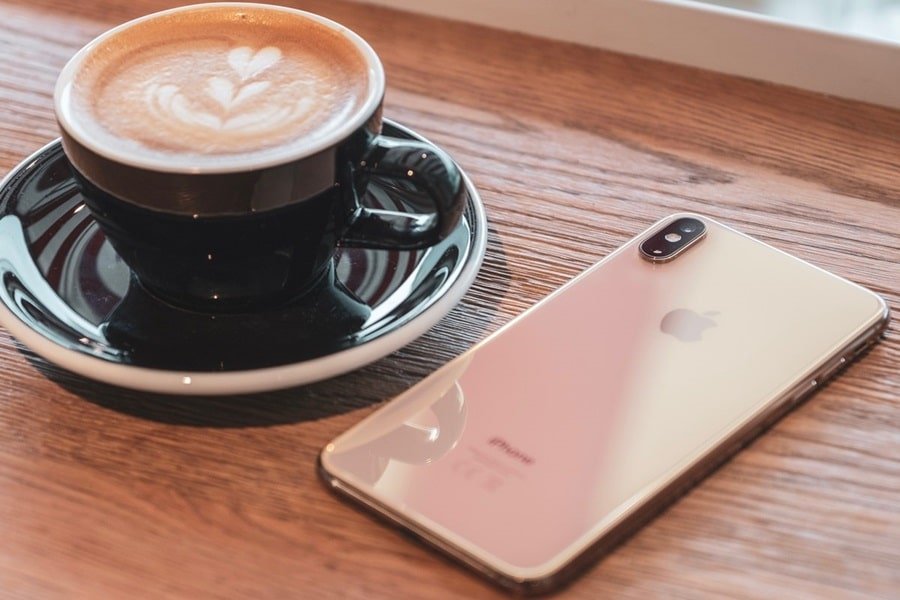
Returning to its tradition of releasing an “S” version, the next chapter in the history of the iPhone came with the release of the iPhone XS and the iPhone XS Plus on September 21, 2018. The main goal of this upgrade was to improve upon the iPhone X, a phone which made considerable changes to the look and functionality of the iPhone, while also improving its speed. In the process of doing this, Apple also made the phone almost completely water and dust-resistant.
READ MORE: Who Invented Water? History of the Water Molecule
iPhone XS and XS Max Improvements and Upgrades
Although Apple put quite a bit of work into making the XS and XS Max seem significantly different than the iPhone X, in reality, the phones are very similar. The X and the XS are almost identical in size, except the XS weighs .01 ounces less. The XS Max, by design, is larger. It has a 6.5 inch/16.5cm screen as compared to 5.8 inches/14.7, and it weighs about an ounce more than the iPhone XS.
Both phones got an upgraded camera, largely with improved HDR and image stabilization technology, and although the front-facing camera remained the same, Apple updated the technology to make sure Face ID works more quickly.
Probably the most significant upgrade is in the processor. Apple improved upon its A11 processor and put an A12 processor with six cores in the iPhone XS and XS Max. It has 4GB of RAM and is capable of speeds up to 2.49 GHz, and it comes preloaded with iOS 12
Both the XS and XS Max are available in 64GB, 256GB, and 512GB models, and prices range from $999-$1349. Lastly, battery life was slightly improved. With the XS and XS Max, you get:
- 20/25 hours of talk time
- 12/13 hours of internet use
- 14/15 hours of wireless video playback
- 60/65 hours of audio playback
Generation 14.2: iPhone XR
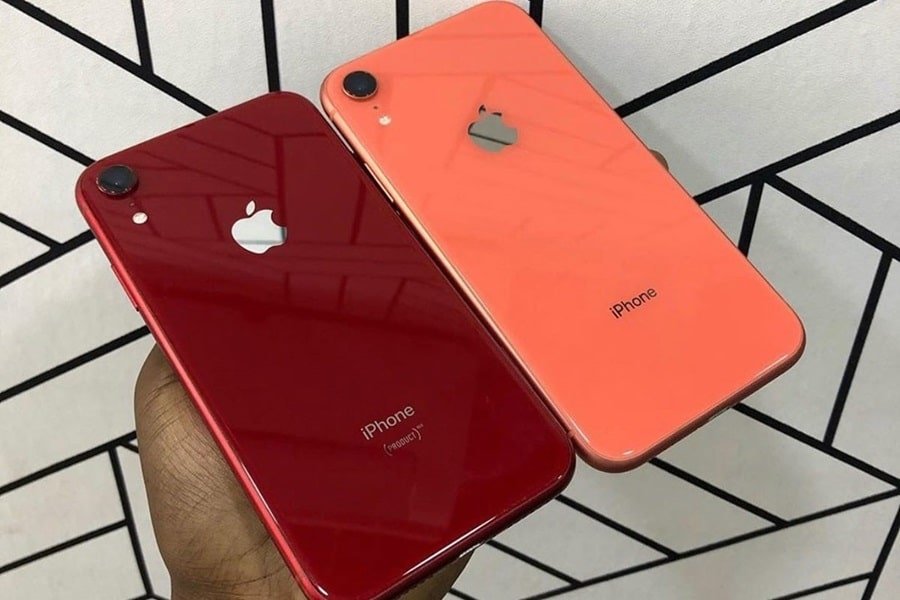
The iPhone XR was announced at the same time as the iPhone XS, but it was released after it on October 26, 2018. It was designed to be a “budget” option of the iPhone XS, although with a starting price tag of $799, it’s tough to justify that moniker. It possesses some of the features of the XS, such as the super-fast A12 Bionic processor, but it is missing some others, such as the OLED, Super Retina display.
iPhone XR Changes
The iPhone XR’s screen got a significant upgrade from that of the iPhone 8, but it did not quite match that of the iPhone X or XS. For example, instead of using an OLED screen, the iPhone X has a “Liquid LCD” screen with a resolution of 1792 x 828 pixels. Pixel density is 326 ppi, which is the same as Apple’s original Retina display, although improvements in color and contrast help make the image clearer and more vivid.
The iPhone XR has the same processor as the iPhone XS, the A12 Bionic, meaning it is significantly faster than the iPhone 8. But instead of 4GB of RAM, the iPhone XR only has three. Like the iPhone XS, the XR is also preloaded with iOS 12.
Furthermore, the camera on the XR is not as good as that of the XS, although it’s much better than the iPhone 8. The main difference is that the iPhone XR does not have a telephoto lens, whereas the iPhone XS does.
Battery life on the iPhone XR is similar to that of the XS, and in some areas, it is actually slightly better. Here’s what you get with the iPhone XR:
- 25 hours of talk time
- 15 hours of internet use
- 16 hours of wireless video playback
- 65 hours of audio playback
Lastly, the iPhone XR is slightly cheaper than the iPhone XS, which was one of the main reasons Apple released this phone. There are three models (64GB, 128GB, and 256 GB), and the lowest option costs $749 whereas the highest prices at $899.
Generation 15.1: iPhone 11
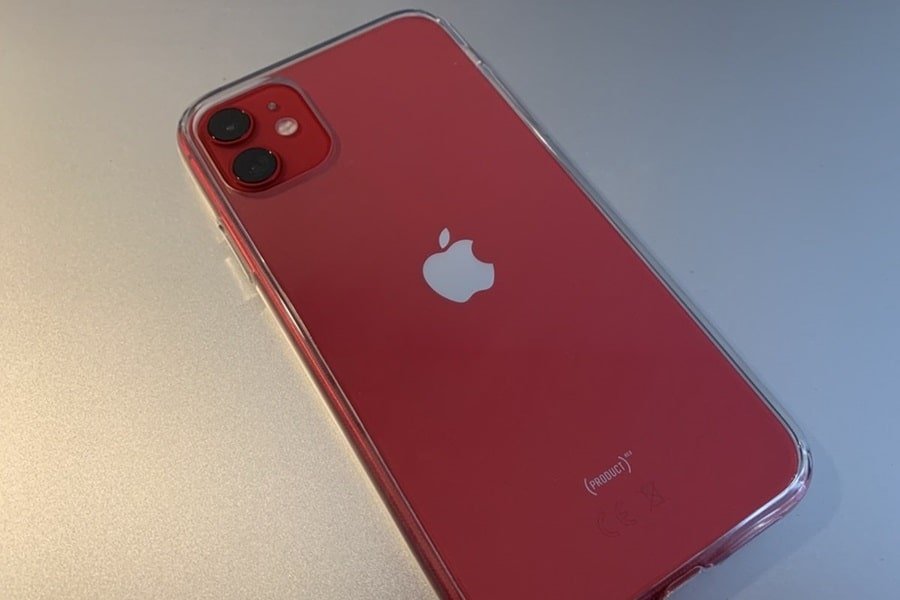
Perhaps the most exciting thing to come from the release of the iPhone in, 2019, is Apple’s decision to abandon its confusing lettering system to return to good ‘ole numbers. Many likely remember when Apple randomly jumped from the iPhone 8 to the iPhone X, which many assumed was a transition to Roman numerals. But what about the iPhone 9? And are they really going to call the next one iPhone XI??
If you’re sweating, don’t worry. We are too. Thankfully, Apple decided to return back to its traditional numbering system (quietly skipping over number 9) and on September 10, 2019, released the iPhone 11.
However, despite this revolutionary reverse to what it’s always been doing, there aren’t a ton of new features on the phone’s 15th generation model. But there are of course some things to be excited about.
iPhone 11
The basic model of 2019’s iPhone is the iPhone 11. It’s the newest model of the iPhone XR, which was designed to be the more budget-friendly option of the iPhone X, and XS.
The look and feel of the phone has not changed much with its update because Apple instead decided to improve on some of the phone’s other features, such as its processor (upgraded to an A13 Bionic) and camera, or cameras.
As with the iPhone XR, the iPhone 11 has two rear cameras, but the newer version is equipped with a 12-megapixel lens. It also offers the option to take wide-angle and “Ultra wide-angle” photos. Other features include a new night mode to improve low-light photography and 4k video capability.
Apple has also improved its front-facing camera to allow for slo-mo videos (dubbed “selfies by Apple…), as well as landscape videos and selfies.
The iPhone 11 also boasts better battery time than its predecessors, with Apple claiming it will last an additional hour.
The base model of the iPhone 11 has 64GB of internal memory, but it is also available in 128GB and 256GB models. The 64GB phone will be released for $699, whereas the 128GB and 256GB phones started at $749 respectively. You will be able to choose between six different colors: white, black, green, yellow, purple, and PRODUCT(RED).
The phone was announced on September 10, 2019, made available for pre-order on September 13, 2019, and shipped/sold in stores on September 20, 2019.
Generation 15.2: iPhone 11 Pro and iPhone 11 Pro Max

In addition to the iPhone 11, Apple also announced on September 10, 2019, the iPhone 11 Pro and iPhone 11 Pro Max. Like the iPhone 11, this iPhone has an updated processor (A13 Bionic) and a longer battery life, although the iPhone Pro and Pro Max are designed to last an additional four hours and five hours more than the iPhone XS and XS Max respectively.
Like the XS and XS Max, the iPhone 11 Pro and Pro Max have an OLED Super Retina display whereas the basic iPhone 11 has an LCD Liquid Crystal display that has less resolution.
However, hands-down the biggest difference between the iPhone Pro/Pro Max and the iPhone 11 is the camera. For the first time in iPhone history, an iPhone will have three cameras on the back of it, one of which is a telephoto lens and one of which is an ultra-wide-angle.
This just shows how much Apple understands the importance of a good camera in a phone. We live in an Instagram era, folks.
But this camera is for more than just social media. It’s designed to help people take professional-grade photos and videos with their phones, and specific apps will be released to help people do this. One example presented by Apple is deep fusion, which takes nine photos using the three lenses almost at once, and then processes these images to find the best version of your subject. Pretty cool stuff.
Internally, the iPhone 11 Pro and Pro Max are the same. The only difference is the size. Following the XS and XS Max, The iPhone 11 Pro has a 5.8-inch screen and the Pro Max has a 6.5-inch screen.
Like the iPhone 11, the base Pro models come with 64GB storage, but you can upgrade to either 256GB or 512MB. The Pro models come in just four colors: Spacy Gray, Midnight Green, Silver, and Gold.
For the Pro model, the pricing is as follows:
- 64GB – $999
- 256GB – $1149
- 512GB – $1349
And for the Pro Max model, the prices on release were:
- 64GB – $1099
- 256GB – $1249
- 512GB – $1449
Generation 16.1: iPhone 12 and 12 Mini
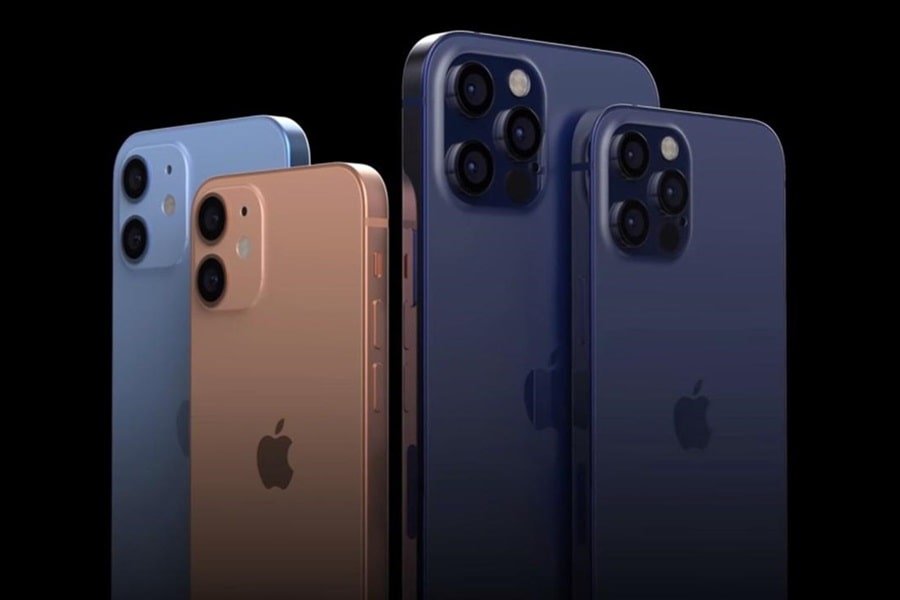
Although 2020 was a crazy year for many reasons, mainly because of the Coronavirus pandemic, some things stayed the same, such as Apple releasing a new iPhone. This generation of iPhones, known collectively as the iPhone 12, marked a new era in the history of the iPhone.
When Did the iPhone 12 Come Out?
The iPhone 12 was released on June 22, 2020, at Apple’s Worldwide Developer Conference. Pre-orders for the iPhone 12 and iPhone 12 Pro began on October 16, 2020, and hit stores on October 23, 2020. For the iPhone 12 Mini and iPhone Pro Max, pre-orders started on November 6, 2020, and they hit stores on November 16, 2020.
The event was an online presentation conducted from its headquarters in Apple Park (the first online presentation in the history of the WWDC events) and was streamed live to an audience of about 1.2 million people on YouTube.
New Features of the iPhone 12
As the latest model of iPhone at the time, the iPhone 12 features several upgrades as compared to the iPhone 11, such as:
Design
The iPhone 12’s design seems to hark back to the earlier models in the device lineup, specifically the iPhone 4, with flat edges and thinner bezels that Apple claims make the device more durable compared to previous generations. This is a major departure from the rounded design used since the iPhone 6.
The front and back ceramic glass panels are bound by an aluminum frame in the iPhone 12 and 12 mini, while the iPhone 12 Pro and Pro Max have a stainless steel frame. The speaker and the TrueDepth Camera are housed in a notch in the top section of the screen. The U.S. models of the iPhone 12 have a new 5G mmWave antenna. This feature will only be made for the iPhone 12’s U.S. market.
The iPhone 12 mini is 5.18 inches tall, 2.53 inches wide, and 0.29 thick while the iPhone 12 is 5.78 inches tall, 2.82 inches wide (71.5mm), and 0.29 inches thick. iPhone 12 models can withstand rain, splashes, and accidental spills thanks to the IP68 water resistance rating. In the IP68 number, the 6 refers to dust resistance (and means the iPhone 12 Pro can hold up to dirt, dust, and other particulates), while the 8 pertains to water resistance. IP6x is the highest dust resistance rating in existence.
The iPhone 12 and 12 mini are available in red, black, white, green, and blue. Like the iPhone 12, the 12 mini has 4GB of RAM and comes in 64GB,128GB, and 256GB storage sizes. All features on these two devices are similar except for the size and weight. The mini weighs in at 4.76 ounces (135 grams) while the iPhone 12 is 5.78 ounces (164 grams) heavy.
Battery Life
The major issue that users might have with the iPhone 12 mini is battery life. Being a smaller device compared to the previous versions, the battery is smaller to fit in the compact design. However, Apple claims that compared to the iPhone 12, the 12 mini can get 10 rather than 11 hours of streaming, and 50 rather than 65 hours of audio playback on a charge. The iPhone 12 and iPhone 12 mini support fast charging and can charge to 50 percent within 30 minutes using a Lightning to USB-C cable and a 20W power adapter.
Display
Screenwise, the iPhone 12 and iPhone 12 mini spot a 6.1-inch and a 5.4-inch Super Retina XDR OLED display respectively. This is an improvement over the iPhone 11’s Liquid Retina IPS LCD display as the XDR display in the iPhone 12 provides a High Dynamic Range that delivers a broad range of dark and light areas in photos and video. There’s a 2,000,000:1 contrast ratio for blacker blacks and brighter whites, and up to 1200 nits peak brightness for HDR photos, videos, TV shows, and movies. Typical max brightness is 625 nits on the iPhone 12 models.
This, coupled with OLED technology, gives the iPhone 12 a much crisper picture experience and better viewing angles than any previous generation of iPhone. Apple also incorporated Dolby Vision and True-Tone technology in the iPhone 12’s display. All iPhone 12 models have nano-ceramic crystals infused in the scratch-resistant glass fascia. This means the device has 4 times better fall resistance compared to the iPhone 11.
Processor and Operating System
The iPhone 12 has a new 5 Nanometer Apple A14 Bionic chipset. This 5nm chipset has 11.5 billion transistors, that’s 3 billion more than its predecessor. A higher transistor count translates to a 15% increase in performance and 30% more power efficiency. The GPU in the A14 chip also offers improved graphics performance for up to 8.3% more than the A13 chip released with the iPhone 11 in 2019.
All iPhone 12 models run on iOS 14, the latest version of Apple’s mobile operating system. iOS 14 is Apple’s biggest iOS update to date, introducing home screen design changes, major new features, Siri improvements, updates for existing apps, and many other tweaks that streamline the iOS interface.
Wireless Charging
Apple has also brought back the MagSafe charging technology. MagSafe utilizes a ring of magnets in all the iPhone 12 models to connect to accessories that also have magnets built inside.
This means a MagSafe Charger snaps onto the back of an iPhone, much like a magnet snaps onto a refrigerator. The design of the magnet ring allows all iPhone 12 models to be compatible with a wide range of accessories that rely on magnets, from chargers to mounts to cases.
All iPhone 12 models also maintain Face ID for biometric identification. The Face ID components are housed in the TrueDepth camera system in the display notch.
In addition to powering facial recognition, the 12-megapixel f/2.2 camera in the TrueDepth camera system is also a front-facing selfie/FaceTime camera with many of the same features that are available for the rear-facing camera.
Cameras
As for the rear camera, both the iPhone 12 and 12 mini spot a dual 12MP camera system: Ultra Wide and Wide cameras. The Ultra-Wide camera has a f/2.4 aperture, a 120-degree field of view, and a 13mm focal length, which is ideal for landscape shots and unique, artistic shots with a super wide-angle field of view.
The Wide camera comes with a 26mm focal length and an f/1.6 aperture that lets in 27 percent more light than the f/1.8 aperture in the iPhone 11 camera.
Since both the iPhone 12 and 12 mini lack a telephoto lens, they only support 5x digital zoom and 2x optical zoom out (with the Ultra Wide lens) but no optical zoom in.
5G Capability
This was the first iPhone to fully support 5G Networks. All iPhone 12 models support the two types of 5G networks: mmWave and Sub-6GHz 5G. As for Bluetooth and WiFi, all the iPhone 12 models support Bluetooth 5.0 and WiFi 6, the newest and fastest WiFi protocol.
READ MORE: Who Invented WiFi? Internet in the Air
Materials
In an effort to limit its environmental impact, Apple has eliminated the power adapter or EarPods in the iPhone 12 and 12 mini’s packaging. The new iPhones ship in a smaller, slimmer box and come with just a standard USB-C to Lightning cable.
iPhone 12 Controversy
The move by Apple to eliminate the power adapter from the iPhone 12’s packaging (for environmental reasons – as Apple claims) has received quite a bit of blowback from around the world.
On 2nd December 2020, Procon-SP, a Brazilian consumer protection agency based in Sao Paolo, released a statement on its website asking Apple to verify the real and specific advantages that not including the iPhone 12 charger represents for the environment and how this action affects the environment in a ‘positive’ way.
Apple responded to the request and claimed that by removing the charger from the packaging, the company was cutting back on carbon emissions produced especially when mining for precious materials that are used in the development of the chargers.
However, Proton-SP was not satisfied by this response and claimed that Apple has no action on a possible application of reverse logistics for the collection of old devices and adapters for recycling and proper disposal, which would impact the protection of the environment.
“When failing to sell the product without the charger, claiming carbon reduction and environmental protection, the company should present a recycling project. Procon-SP will demand that Apple present a viable plan, added Fernando Capez, executive director of Procon-SP.
Apple’s conduct is still under review by Procon-SP and if there are any violations of the law, the company may be fined as stipulated in the Consumer Protection and Defense Code. This could mean that iPhone 12 users in Brazil might have the charger included when purchasing their devices in the coming months.
There have also been reports by users of a much higher battery drain rate than expected. Users have been complaining in the Apple forums about the iPhone 12 (especially the Pro models) draining battery power by 20-40% while on standby.
A majority of complainants are also pointing out that it’s a huge dip compared to the iPhone 11 Pro even when they were expecting a drop in battery life due to the inclusion of 5G alongside more powerful hardware. Apple has yet to address this issue.
Similarly, another group of users on the Apple forums complained about signal loss on their new iPhone 12 devices. As per the users, many of them see a drop in the network just after a few minutes of usage.
The issue is most prominent while driving or traveling. The problem is present in all the iPhone 12 models, as the phone drops network connectivity either 5G or LTE in the areas with good network reception. There are threads on Reddit, concerning the same issue reported by multiple users worldwide. Indian users are also affected by this issue on their 4G networks.
However, most users are hoping that the signal and battery issues are software-related and that Apple could fix the problem with the next iOS update.
Generation 16.2: iPhone 12 Pro and iPhone 12 Pro Max
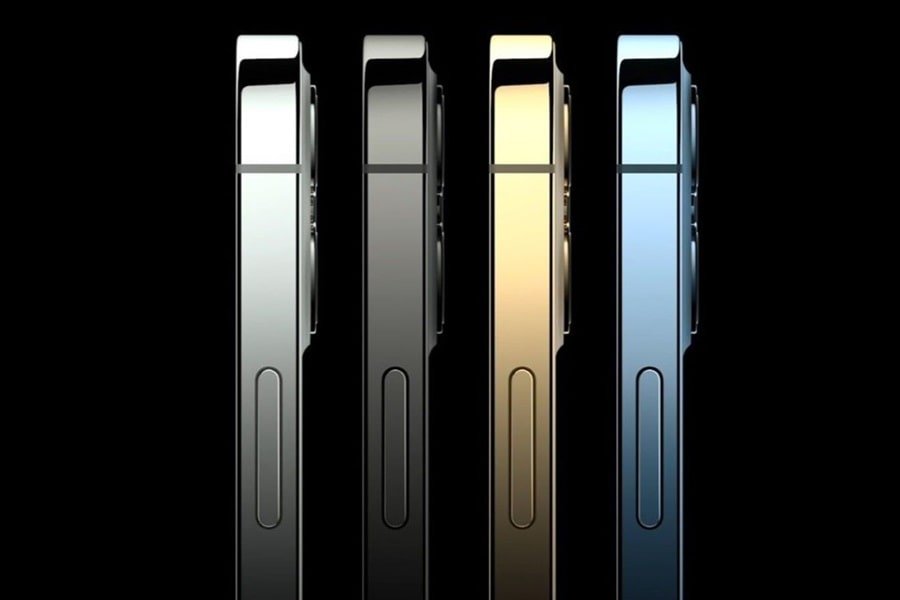
Alongside the iPhone 12 and iPhone 12 mini, Apple also introduced the higher-end versions of the device, the iPhone 12 Pro and iPhone 12 Pro Max. The major difference between these two devices is camera technology.
Camera
The Pro also incorporates Apple ProRaw Capture gives the user access to more image data so you can get a head start on editing, with noise reduction and multi-frame exposure adjustments already in place — and have more time to tweak color and white balance.
The iPhone 12 Pro’s camera also incorporates 4K HDR Dolby Vision offering a cinematic look in video scenes with stronger contrasts for up to 60 fps.
Designed for Pros
These two devices are great assets to more ‘camera-centric’ individuals like content creators and photographers who are willing to pay more for better camera features.
For the average user, who takes a normal selfie, the base versions of the iPhone 12 should offer adequate camera features if not better than other smartphones in this niche market.
The iPhone Pro Max has all the features of the iPhone 12 Pro, plus a wide-angle camera with a 47% larger sensor. Giving the sensor sites more room and making them larger makes them more sensitive to light. More light means more signal, less noise, and sharper results.
The Pro Max also has a sensor shift on the wide-angle camera that assists in image stabilization, especially in high exposure photography, and a 65mm telephoto focal length lens that offers a 5x total optical zoom range. The iPhone 12 Pro Max’s camera offers users, especially professional photographers, more tools and functionality to nail that perfect shot.
Display and Storage
In addition to the upgraded camera technology, the Pro Max also has a 6.7-inch Super Retina XDR OLED display, making the device the largest in iPhone history.
Both devices have the 512GB internal storage option, which is 256GB more than is available with the base and mini versions. This is plenty of storage to accommodate the RAW image files from their advanced camera setup.
Price
The iPhone 12 retails at $799. The mini version starts at $699, while the Pro and Pro Max versions retail at $999 and $1,099 respectively. Compared to other smartphones in this market segment, for example, the Huawei P40 Pro Plus ($1,159), Samsung Galaxy Note 20 Ultra ($1,049), and Google Pixel 5 ($829).
READ MORE: Who Invented Google? The Story Behind The Search Engine
The iPhone 12 base and mini versions are a bit affordable, but for users who are willing to throw in a few extra bucks for that camera magic, the iPhone 12 Pro and Pro Max offer greater camera performance and functionality than their Android competitors.
Generation 16.3: The iPhone SE (Mk. 2)
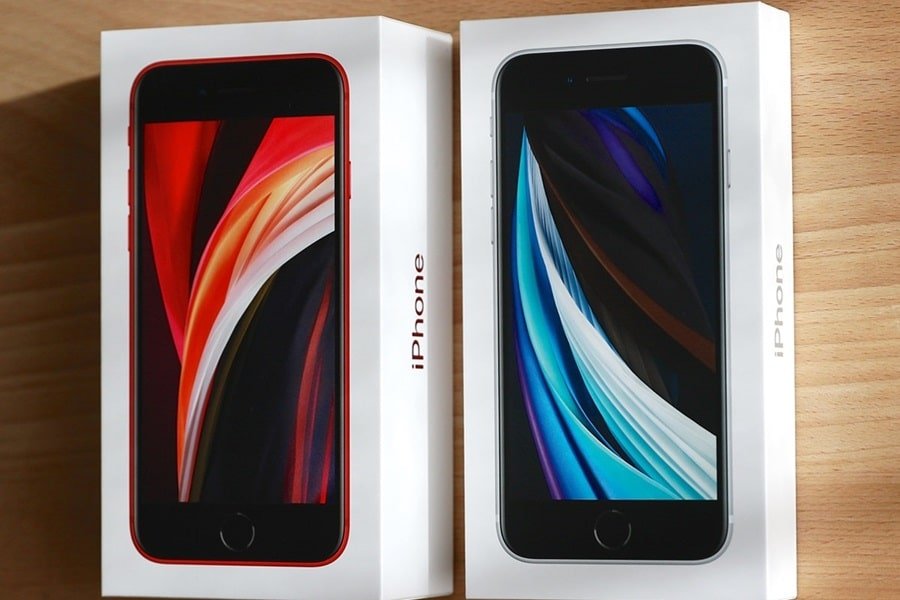
In 2020, Apple also brought back the iPhone SE after a 2-year hiatus. The original iPhone SE (which resembled the iPhone 5) came out in 2016 and was a low-cost alternative to the iPhone 7 that came out the same year. The brand was however discontinued in 2018.
When Did the Second iPhone SE Come Out?
Apple revived the name “SE” and announced the second iPhone SE on April 15, 2020. Pre-orders began on April 17, 2020, and the phone was officially released on April 24, 2020.
It was a new 4.7-inch device that looked like an iPhone 8 with features similar to those of the iPhone 11.
Available in red, black, and white, the new iPhone SE has a front and back glass cover and a color-matching aluminum frame in the middle. Like its counterpart from 2016, the iPhone SE comes at a budget retail price. The SE is available in three internal memory configurations; 64GB, 128GB, and 256GB. All iPhone SE versions have 3GB of RAM.
This device is aimed at users who want top-notch performance from an iPhone but feel like the flagship iPhone 12’s price is too steep.
Since the iPhone SE is physically identical to the iPhone 8, it continues to feature thick top and bottom bezels. The top bezel accommodates the 7-megapixel front-facing camera and microphone while the bottom bezel includes a Touch ID Home button that’s also a fingerprint reader.
The iPhone SE is the only iPhone in Apple’s current lineup that features Touch ID over Face ID. Like other iPhones, it still uses Haptic Touch for Quick Actions and contextual menus, with 3D Touch, which is currently removed from the iPhone 12 models.
The device comes with a 4.7-inch Retina HD LCD display with True Tone to match the ambient lighting in a room, a wide color gamut, Dolby Vision, and HDR10. Unlike the iPhone 12 which has a ceramic-induced glass cover, the iPhone SE’s front glass panel is made from ion-strengthened glass with an oleophobic coating that is fingerprint resistant.
At the back, the iPhone SE sports a single-lens 12-megapixel rear camera with an f/1.8 aperture, optical image stabilization, and support for Portrait Mode and Portrait Lighting. However, unlike its flagship siblings, it doesn’t incorporate the night portrait mode so pictures taken at night will be quite dark in comparison.
For night-time photography, the iPhone SE will be assisted by a TrueTone LED Flash with Slow Sync capabilities, smart high dynamic range, and wide color support. The iPhone SE’s camera can record 4K video at up to 60 frames per second with optical image stabilization and support for slow-motion video and time-lapse video.
For the operating system, the iPhone SE originally ran on iOS 13 but later on, Apple upgraded it to the new iOS 14. The software is powered by the same A13 Bionic chip that was used on the iPhone 11.
The A13 Bionic has a dedicated 8-core neural engine that can perform 5 trillion operations per second, two Machine Learning Accelerators on the CPU, and a Machine Learning Controller for better performance and efficiency. Despite it being more than a year old, Apple’s A13 chip is a very capable processor and when paired with 3GB of RAM, the device is capable of keeping up with other mid-range phones in its price bracket.
As for battery life, the iPhone SE can last for 13 hours when watching videos, eight hours when streaming videos, and 40 hours when listening to audio. It is capable of fast charging and can charge up to 50 percent in 30 minutes when using an 18W power adapter or higher. Wireless charging is also supported.
The 2020 iPhone SE is also dust, splash, and water-resistant with an IP67 rating meaning that it can withstand a depth of 1 meter for 30 minutes.
The iPhone SE is 5G capable and has support for WiFi 6 along with Bluetooth 5 and Gigabit-class LTE with 2×2 MIMO. It also has NFC with reader mode and supports Express Cards (transit cards) with a power reserve feature that allows cards to be accessible even when the battery is dead.
Price-wise, the 64GB version of the iPhone SE is priced at $399, the 128GB model is priced at $449 and the 264GB model sells for $549.
Generation 17.1: iPhone 13 and iPhone 13 Mini
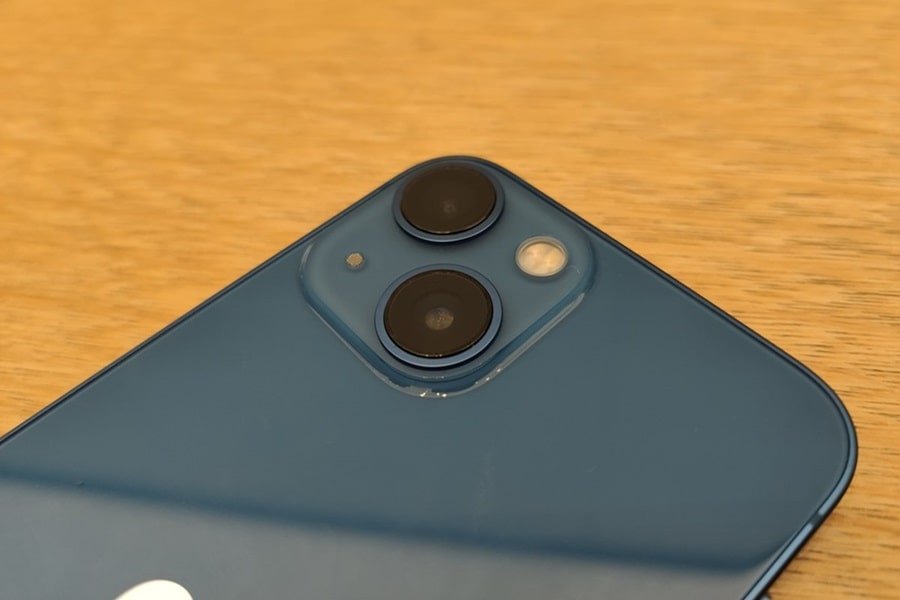
Just a little more than one year after the release of the iPhone 12, Apple introduced the next model in its long line of iPhone generations: the iPhone 13, which has four total variations: the iPhone 13, iPhone 13 mini, iPhone 13 Pro and iPhone 13 Pro Max.
When Was the iPhone 13 Released?
The iPhone 13 was announced on September 14, 2021. Pre-orders started on September 17, 2021, and the device became available starting on September 24, 2021.
New Features of the iPhone 13
Like the iPhone 12, the iPhone 13 comes equipped with 5G capabilities, though iPhone 13 users will be able to access even faster speeds. The iPhone 13 also mimics the design of the iPhone 12 with a flat-edge display and an aluminum frame.
But one year after the release of the iPhone 12, here’s what’s changed in the new model:
- Longer battery life –Thanks to an improved processor, better components, and a better integration of hardware and software, the iPhone 13 has a considerably longer battery life than the iPhone 12. Specifically, the iPhone 13 lasts about 2.5 hours longer than the iPhone 12, and the iPhone 13 Mini lasts around 1.5 hours longer than the iPhone 12 mini.
- Improved camera – The two cameras on the back of the iPhone 13 are diagonally arranged to enable Apple’s signature dual-camera system. This allows the iPhone 13 to capture up to 47 percent more light, and enhanced image stabilization technology allows the iPhone 13 to capture more detail in darker areas.
- Professional video recording – The iPhone 13 comes with what is known as “Cinematic mode.” This incorporates technologies, such as automatic focus changes, to allow users to shoot cinema-quality videos even if they aren’t professionals. In addition, the iPhone 13 captures videos in such a way that allows for advanced editing in iMovie, which makes it easier for users to produce professionally finished products.
- iOS 14 and A15 Processor – As is usually the case, Apple has updated both the phone’s operating system (iOS) and processor. This makes the iPhone 13 the fastest iPhone on the market and makes possible features such as portrait-mode FaceTime calls, augmented reality, and 3D maps, and it also introduces new security and privacy controls.
- Recycled materials – In line with Apple’s goal of becoming carbon neutral by 2030, the iPhone 13 includes several recycled materials, such as antenna lines made from upcycled plastic water bottles, 100 percent recycled magnets and gold, and less plastic wrap in the packaging.
Generation 17.2: iPhone 13 Pro and iPhone 13 Pro Max

Just like it did in 2020, when Apple released the iPhone 13 in 2021 it came out with two different versions: iPhone 13/iPhone 13 Mini and iPhone 13 Pro/iPhone Pro Max
The two are very similar, but there are a few key differences, mainly:
- Screen size – the iPhone 13 Pro Max has a 6.7″ Super Retina XDR display with ProMotion. The iPhone 13 Pro has a 6.1″ Super Retina XDR display with ProMotion, whereas the standard iPhone 13 has a 6.1″ display without ProMotion. The iPhone 13 Mini has a 5.4″ display.
- Cameras – The iPhone 13 Pro and Pro Max both have three cameras and a telephoto lens alongside the wide lens. They also have a 6x Optical zoom range as opposed to just 2x on the standard iPhone 13
- Battery life – The iPhone 13 Pro Max has a battery life of 28 hours, the iPhone 13 Pro has a 22-hour lifespan, the iPhone 13 lasts for 19 hours, and the iPhone 13 mini lasts for around 17 hours.
- Capacity – All iPhone 13 models have capacity options of 128GB, 256GB, and 512 GB, but the Pro and Pro Max also have 1TB options.
- Price – The iPhone 13 Pro Max starts at $1099, the iPhone Pro starts at $999, and the iPhone 13 and iPhone 13 Mini retail at $799 and $699 respectively.
Generation 18: iPhone 14, 14 Plus, 14 Pro, 14 Pro Max
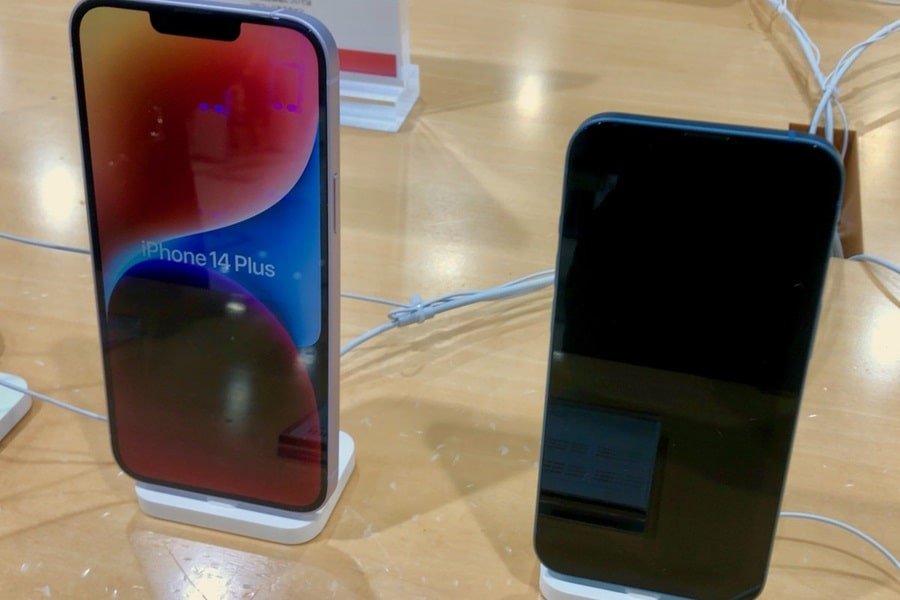
Almost one year to the date after the release of the iPhone 13, Apple announced the newest version of the iPhone, the iPhone 14. Technically the 18th generation of this landmark phone, not a whole lot changed between 2021 and 2022.
One big thing Apple did with the release of the iPhone 14 is get rid of the Mini. For the previous two years, Apple experimented with smaller devices, but poor sales suggested people wanted bigger screens so Apple had stopped, for now, releasing this version of its device.
When Was the iPhone 14 Released?
Apple announced the release of the new iPhone 14 on September 7, 2022. Pre-order sales began on September 9, 2022, and the phone first became available on September 17, 2022.
New Features of the iPhone 14
- Better front and rear cameras – As always, a big focus of Apple’s new device was the camera. On the iPhone 14, both the front and back cameras got an upgrade, improving the quality of selfies and also making it easier to take high-quality photos in low light.
- Dynamic Island – No, this is not a reality TV show, but rather the most exciting feature of the iPhone 14 as compared to the iPhone 13. This display bar fits over the selfie camera on the front of the screen and makes this space useful, instead of just making a hole in the display. You can change settings, and get useful information such as time and battery use, and other things on this dynamic bit of hardware that adds function to a previously underused part of the phone.
- Enhanced emergency features –Our phones are a big lifeline for us in the event of an emergency. Apple took this into consideration when building the new iPhone 14 by including features such as Crash Detection. Using motion sensors and other built-in technology, the phone will be able to automatically detect when you’ve been in a car accident and can contact emergency services for you.
- Improved display brightness – Only relevant to the Plus, Pro, and Pro Max, the iPhone 14 features the brightest screen in the iPhone lineup, which is Apple’s response to the reality that more and more people are using their phones to consume digital media.
- Storage – The iPhone 14 is available with either 256 or 512 GB of internal memory, in addition to available iCloud storage.
Generation 19: iPhone 15
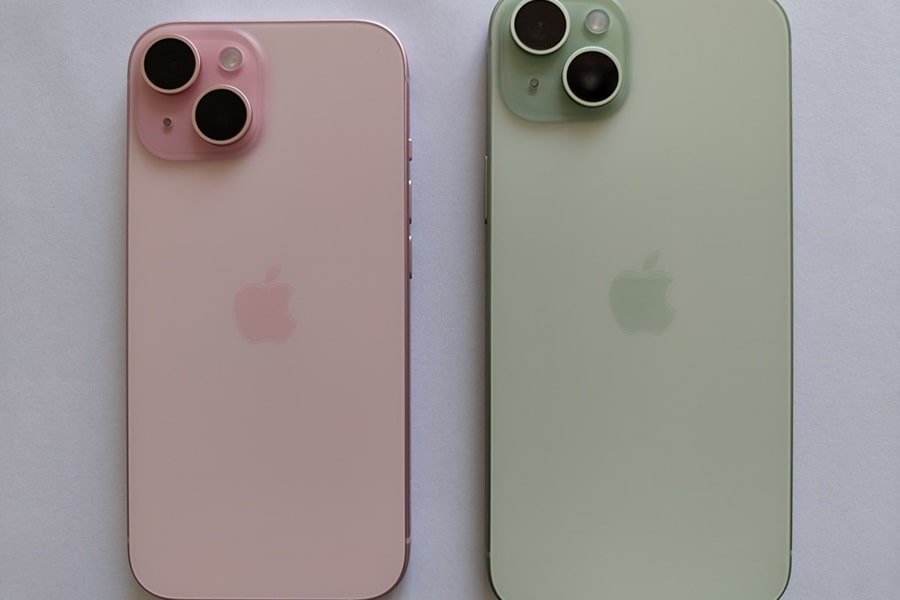
In September 2023, Apple unveiled the much-anticipated iPhone 15 series at its annual event, which was held both in-person and virtually. This event marked a return to more traditional, pre-pandemic presentation formats, while also retaining the digital accessibility that had become popular over the previous years. The iPhone 15 series was officially released to the public in late September 2023.
New Features of the iPhone 15
Apple’s iPhone 15 series, introduced in September 2023, marks another significant step in the evolution of the iPhone. Building on the innovations of previous models, the iPhone 15 series comes with a range of new features and enhancements that solidify its position as a leader in the smartphone market.
- Design and Display – The iPhone 15 retains the sleek design language of its predecessors, with some subtle yet impactful tweaks. The bezels are further reduced, providing an even more immersive edge-to-edge display experience. The Pro models feature a new, advanced Super Retina XDR display, offering higher brightness levels and improved color accuracy. The standard iPhone 15 models also see a bump in display quality, with enhanced HDR capabilities.
- Camera System – The camera system on the iPhone 15 series receives significant upgrades. The Pro models now feature a quad-camera setup, including a new sensor that dramatically improves low-light photography and videography. The standard models are equipped with a triple-camera system, including a new telephoto lens that offers better zoom capabilities and depth sensing for portrait shots. Apple introduced a new image processing algorithm that enhances photo clarity and color reproduction, making the iPhone 15’s camera one of the most advanced in the smartphone market.
- Processor and Performance – Powering the iPhone 15 is the new A17 Bionic chip, which offers faster performance and greater efficiency. This results in smoother operation, quicker app loading times, and enhanced gaming experiences. The A17 chip also brings improvements in machine learning and AI tasks, enhancing features like Siri, facial recognition, and augmented reality applications.
- Battery Life and Charging – The iPhone 15 series sees an improvement in battery life, thanks to the more efficient A17 chip and larger battery capacities. Apple introduces a new, faster wireless charging technology that significantly reduces the time needed to fully charge the device.
- Software and Connectivity – The iPhone 15 runs on iOS 17, which introduces new customization options, enhanced privacy features, and seamless integration with other Apple products. The series supports the latest Wi-Fi 6E and 5G standards, ensuring faster internet speeds and more reliable connectivity.
- Environmental Initiatives – Continuing its commitment to the environment, Apple has increased the use of recycled materials in the iPhone 15’s construction. The packaging is further reduced and now completely eliminates single-use plastics.
- Models – The iPhone 15 series is available in four models: the iPhone 15, iPhone 15 Mini, iPhone 15 Pro, and iPhone 15 Pro Max. Each model is available in multiple storage options, starting from 128GB to 1TB for the Pro models. The iPhone 15 series is available in new color options, including a striking new midnight blue and a refreshed rose gold, alongside the classic space gray, silver, and gold.
With the iPhone 15 series, Apple continues to push the boundaries of smartphone technology. The combination of cutting-edge hardware, sophisticated software, and a focus on environmental sustainability makes the iPhone 15 a compelling choice for consumers seeking the latest in mobile innovation.
The Next Chapter in iPhone History
If history tells us anything, then the next chapter of iPhone history should begin in the fall of 2021. However, we won’t really know for sure what this will mean until it happens.
- Will Apple simply come out with an updated version of its latest device?
- Will they break the mold and come out with something truly groundbreaking?
- Will they finally find a way to prevent people from working out how to unlock their iPhones?
- Will they once again remove the iOS exploits used to jailbreak their iPhones?
- Is the 4 lens camera just hype or is it the real deal?
Only time will tell, but the one thing we know for sure is that the history of the iPhone is far from over.
READ MORE: The History of Marketing
My first iphone was iphone 3G and I used it for a long time without any problems but with the generations from generation to generation I had problems and I had to replace it. This issue with the updates still exists and maybe even worse. Although they make some extraordinary software products, nobody understands why it is necessary to create bugs to force you to change your iPhone.
They just want you to buy a new phone and spend more money
this is grate
Watch out I think moto moto likes you…
A very useful history. Thank you. Most iPhone histories miss on the key aspects about the iPhone architecture and strategy that eviscerated the carriers. Namely by maintaining control of the OS and agnosticity with respect to internet access (2/3/4G or wifi for any app) they removed the carriers from having any control over what happened above layer 2 in the informational stack. Verizon knew this would happen and believed it’s better 2G and quickly evolving 3G network would allow it to maintain control over its silo. Cingular (AT&T) who had challenges with coverage and throughput of its 2G network had to cave to Jobs’ demands about OS autonomy wrt access.
This is a great post. The X series of iPhone is really good.
Visual Voicemail was actually just the concept of having voicemails appear onscreen and accessing them that way, rather that by calling in to your VM service and using the number pad (man that sucked). That, and actual Voicemail-to-text was a feature that had been experimented with before (I believe Google pioneered the VM-to-text feature, actually), thru their now discontinued online phone services – but only more recently added to iOS, iirc. I remember getting VM sent to me as SMS text using this Google feature quite some time before the iPhone or Android devices were even out, as well as ‘visual voicemail’, albeit without a touchscreen (maybe on my Blackberry, or that T-Mobile exclusive phone where the screen flipped up and showed a keyboard… I forget the model.). I’m sure if you dig you can verify almost all of this. I might be a little fuzzy on details, but I’m sure this is a fairly accurate recount of things.
Would I be able to find out who the author is (if there is one) and when this was originally posted. I like the in depth history that this article has so that I can properly give credit and cite
Do you have any information on what Apple is planning next wth the iphone?
idk
hi, how can i get more information adout phones, doing a project
What information are you looking for?
hi, how could i get more information maybe im doing a project with some friends thank you.
Sincerely Your New Reader.
how long did it take you to do this
Very good article
IPhone has come a long way.
Good read
The article on the history of the iPhone was very informative, I have a 6 s plus am very happy with it a little confused at times but generally plesed
This was a good read. Thank you for it. I have an iPhone 5c! and of course am upgrading. This article helped me decide on my next choice. Sounds like an XS will do me good. Thanks again
How can I site this article?
Fantastic
The iPhone 6 and 6 Plus ushered in a new era of sleek design and larger screens, changing the game. How did this generation redefine your smartphone experience?